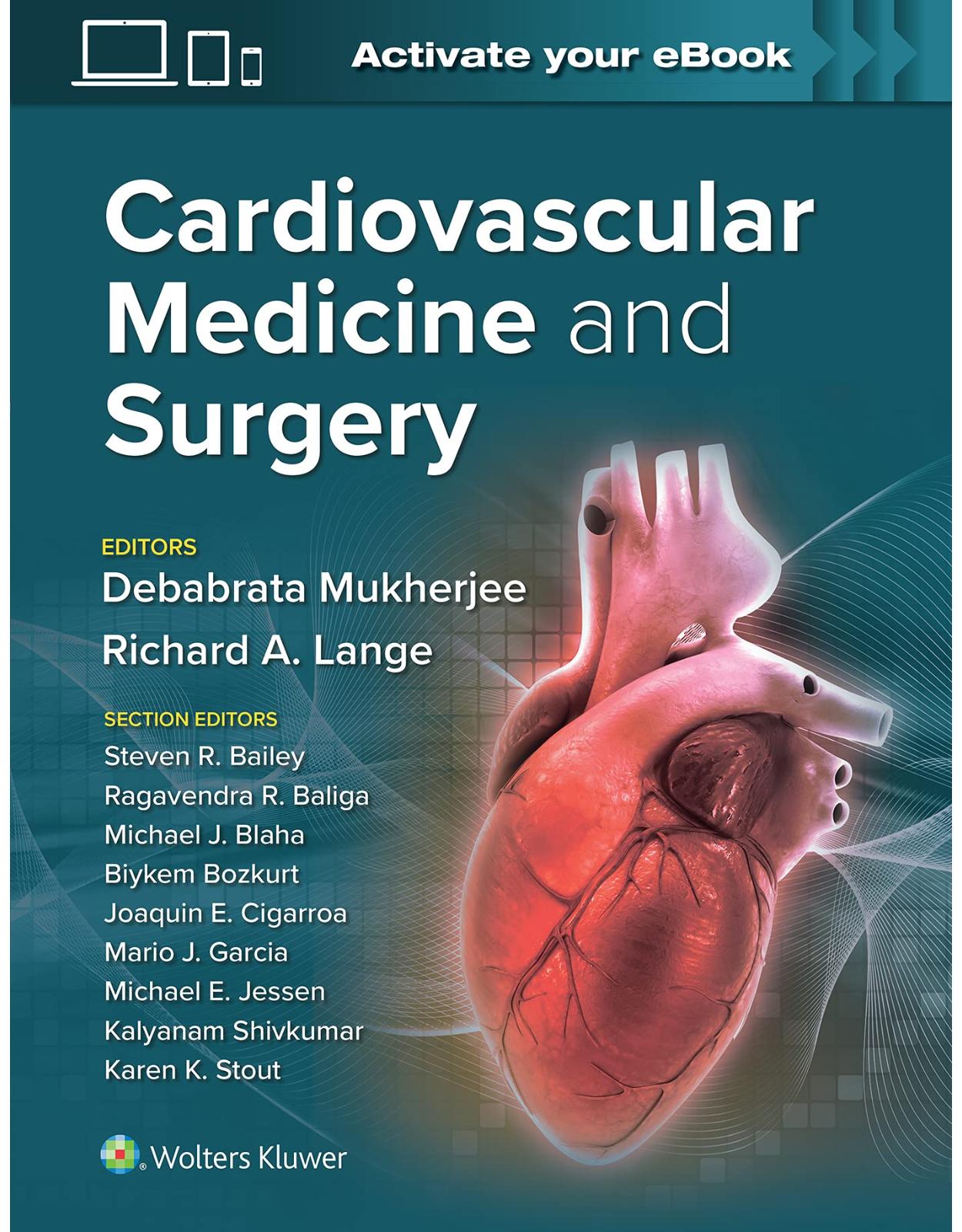
Cardiovascular Medicine and Surgery
Livrare gratis la comenzi peste 500 RON. Pentru celelalte comenzi livrarea este 20 RON.
Disponibilitate: La comanda in 3-4 saptamani
Editura: LWW
Limba: Engleza
Nr. pagini: 1100
Coperta: Hardcover
Dimensiuni: 213 x 276 mm
An aparitie: 25/01/2022
Description:
Written by clinicians, for clinicians, Cardiovascular Medicine and Surgery offers a comprehensive, authoritative, and multidisciplinary approach to this rapidly evolving field. Covering every area relevant to the daily practice of cardiovascular medicine, this new and innovative reference text, led by Drs. Debabrata Mukherjee and Richard A. Lange, brings together a stellar team of cardiovascular specialists from leading medical centers worldwide who focus on cutting-edge strategies for the clinical and surgical management of patients. Both medicine and surgery are highlighted in chapters along with follow-up care and changing technology to equip the clinician for optimal patient care. Highly structured and templated chapters cover pathogenesis, diagnosis, management, special considerations/limitations, follow-up care, and on-going and future research.
Table of Contents:
SECTION 1: CLINICAL CARDIOLOGY
1 The Patient History
HISTORY: KEY STEP IN DIAGNOSIS
CARDIAC DISEASE SYMPTOMS
Chest Discomfort
Stable Angina
Unstable Angina
Dyspnea
Syncope
Palpitations
Claudication
REFERENCES
2 General Cardiovascular Exam
INTRODUCTION
INDICATIONS
FUNDAMENTALS AND CLINICAL APPLICATION OF THE PHYSICAL EXAMINATION
The Extracardiac Examination
General Appearance
Skin
Head and Neck
Extremities
Chest and Abdomen
Cardiac Examination
Jugular Venous Pressure
Measuring Blood Pressure
Assessing the Pulse
Palpation of the Heart
Cardiac Auscultation
LIMITATIONS OF TECHNIQUE
RESEARCH AND FUTURE DIRECTIONS—COVID-19
REFERENCES
3 Clinical Pharmacology: Pharmacogenomics, Pharmacovigilance, Pharmacoepidemiology, and Pharmacoeconomics
INTRODUCTION
PHARMACOGENOMICS
PHARMACOECONOMICS
PHARMACOVIGILANCE AND PHARMACOEPIDEMIOLOGY
REFERENCES
4 Stable Ischemic Heart Disease
INTRODUCTION
Epidemiology
Risk Factors
PATHOGENESIS
CLINICAL PRESENTATION
Common Signs and Symptoms
Physical Examination Findings
Differential Diagnosis
DIAGNOSIS
Patient Risk and Recommendations for Further Testing
Noninvasive Stress (Functional) Testing
Noninvasive Anatomic Imaging
Cardiac Computed Tomography Angiography
Combined Imaging
Coronary Angiography
MANAGEMENT OF PATIENTS WITH STABLE ISCHEMIC HEART DISEASE
Medical Approach
Antianginal Therapies
Nonpharmacologic Therapies for Refractory Angina in Stable Ischemic Heart Disease
Medical Therapy to Reduce Cardiovascular Risk
Patient Risk Factor Management
Percutaneous and Surgical Revascularization
Revascularization for Survival
Revascularization for Symptoms
Coronary Artery Bypass Graft Revascularization
Percutaneous Coronary Intervention Revascularization
SPECIAL CONSIDERATIONS
Unprotected Left Main Coronary Artery Revascularization
Revascularization in Multivessel Disease
Revascularization and Diabetes Mellitus
Hybrid Revascularization
FOLLOW-UP PATIENT CARE IN STABLE ISCHEMIC HEART DISEASE
RESEARCH AND FUTURE DIRECTIONS
REFERENCES
5 Unstable Angina, Non–ST-Elevation Myocardial Infarction-Acute Coronary Syndrome
INTRODUCTION
Epidemiology
PATHOGENESIS
CLINICAL PRESENTATION
DIAGNOSIS
History and Symptoms
Physical Examination
Electrocardiogram
Cardiac Biomarkers
Diagnostic Imaging
Risk Stratification
MANAGEMENT
Antianginal Therapy
Oxygen
Nitrates
Analgesics
Beta-blockers
Calcium Channel Blockers
Ranolazine
Anticoagulant Therapy
Unfractionated Heparin
Low-molecular-weight Heparin
Bivalirudin
Fondaparinux
Argatroban
Antiplatelet Therapy
Aspirin
P2Y Inhibitors
Clopidogrel
Prasugrel
Ticagrelor
Cangrelor
Glycoprotein IIb/IIIa Receptor Inhibitors
Lipid-Lowering Therapy
Statins
Renin-Angiotensin-Aldosterone System Inhibition
Angiotensin-converting Enzyme Inhibitors
Aldosterone Receptor Antagonists
Invasive Therapy
Ischemia-Guided Strategy Versus Early Invasive Strategies
SPECIAL PATIENT POPULATIONS
Older Patients
Patients in Cardiogenic Shock
FOLLOW-UP PATIENT CARE
RESEARCH AND FUTURE DIRECTIONS
REFERENCES
6 ST-Elevation Myocardial Infarction
INTRODUCTION
Epidemiology
Risk Factors
PATHOGENESIS
CLINICAL PRESENTATION
DIAGNOSIS
Emergent Electrocardiogram
Emergent Bedside Echocardiogram and Other Possible Diagnostic Testing
MANAGEMENT
Immediate Therapies
Reperfusion Strategies
Primary Percutaneous Coronary Intervention
Fibrinolytic Therapy
Surgical Approach
SPECIAL CONSIDERATIONS
Cardiogenic Shock
Cardiac Arrest
Nonreperfused Patients
Patients Taking Oral Anticoagulation
Multivessel Coronary Artery Disease
Microvascular Dysfunction
Myocardial Infarction with Nonobstructive Coronaries
Heart Blocks
Other Medications and Devices
Lipid-Lowering Therapy
-Blockers
Angiotensin Converting Enzyme Inhibitors or Angiotensin Receptor Blockers
Aldosterone Antagonists
Implantable Cardioverter Defibrillator (ICD)
PATIENT RECOVERY AND FOLLOW-UP
RESEARCH AND FUTURE DIRECTIONS
VIDEO CAPTIONS
REFERENCES
7 Acute Myocardial Infarction: Complications
INTRODUCTION
MECHANICAL COMPLICATIONS OF ACUTE MYOCARDIAL INFARCTION
Acute Mechanical Complications
Cardiogenic Shock
Right Ventricular Infarction
Cardiac Free Wall Rupture
Ventricular Septal Rupture
Papillary Muscle Rupture
MANAGEMENT OF ACUTE MECHANICAL COMPLICATIONS AFTER MYOCARDIAL INFARCTION
CHRONIC MECHANICAL COMPLICATIONS
Left Ventricular Aneurysms
Left Ventricular Thrombus
Ventricular Failure
ARRHYTHMIC COMPLICATIONS OF ACUTE MYOCARDIAL INFARCTION
Tachyarrhythmias
Atrial Arrhythmias
Ventricular Arrhythmias
Bradyarrhythmia
PERICARDIAL COMPLICATIONS OF MYOCARDIAL INFARCTION
Postmyocardial Infarction Pericarditis
Postmyocardial Infarction Pericardial Effusion
REFERENCES
8 Refractory Angina
INTRODUCTION
Prevalence
PATHOGENESIS
MANAGEMENT OF THE PATIENT WITH REFRACTORY ANGINA
Medical Approach
Percutaneous Coronary Interventions
Surgical Approach
SPECIAL CONSIDERATIONS AND EMERGING THERAPIES
RESEARCH AND FUTURE DIRECTIONS
REFERENCES
9 Rheumatic Heart Disease
INTRODUCTION
Epidemiology
PATHOGENESIS
Natural History
CLINICAL PRESENTATION
DIAGNOSIS
MANAGEMENT OF THE PATIENT WITH RHEUMATIC HEART DISEASE
Antibiotic Treatment of Group a Streptococcal Throat Infection
Treatment of Valvular Heart Disease and Congestive Heart Failure
Mitral Stenosis
Mitral Regurgitation
Aortic Stenosis
Aortic Regurgitation
Congestive Heart Failure
PREVENTION
FUTURE DIRECTIONS
REFERENCES
10 Mitral Valve Disease
INTRODUCTION
Epidemiology
Mitral Stenosis
PATHOGENESIS
Mitral Regurgitation
Degenerative Mitral Regurgitation
Functional Mitral Regurgitation
Mitral Stenosis
CLINICAL PRESENTATION
Common Signs and Symptoms
Mitral Regurgitation
Mitral Stenosis
Differential Diagnosis
Mitral Regurgitation
Mitral Stenosis
DIAGNOSIS: MITRAL VALVE DISEASE
Echocardiography
Magnetic Resonance Imaging
Computed Tomography
Positron Emission Tomography
Cardiac Catheterization
Mitral Stenosis
Mitral Regurgitation
MANAGEMENT OF THE PATIENT WITH MITRAL VALVE DISEASE
Medical Approach: Mitral Regurgitation
Degenerative Mitral Regurgitation
Functional Mitral Regurgitation
Medical Approach: Mitral Stenosis
Heart Rate Control/Prevention of Tachycardia
Control of Pulmonary Congestion
Management of Thromboembolism
Management of Pregnancy
Percutaneous Transcatheter Interventions
Mitral Regurgitation
Mitral Stenosis
Surgical Approach
Surgery for Mitral Regurgitation
Mitral Valve Repair and Replacement
Surgery for Functional Mitral Regurgitation
Rheumatic Mitral Stenosis
Degenerative (Nonrheumatic) Mitral Stenosis
FOLLOW-UP PATIENT CARE
RESEARCH AND FUTURE DIRECTIONS
REFERENCES
11 Aortic Valve Disease
INTRODUCTION
AORTIC STENOSIS
EPIDEMIOLOGY AND FACTORS CONTRIBUTING TO THE DEVELOPMENT OF AORTIC STENOSIS
CLINICAL PRESENTATION: AORTIC STENOSIS
Clinical Signs of Aortic Stenosis
DIAGNOSIS: AORTIC STENOSIS
MANAGEMENT: AORTIC STENOSIS
Medical Management
Interventional Therapy
Aortic Valve Replacement
Minimally Invasive Aortic Valve Replacement
Totally Endoscopic Aortic Valve Replacement
Aortic Valve Disease Associated With Aortic Root Dilation
Transcatheter Approaches
PATIENT FOLLOW-UP: AORTIC STENOSIS
AORTIC REGURGITATION
CHRONIC AORTIC REGURGITATION
Etiology
Hemodynamics in Chronic Aortic Regurgitation
Clinical Presentation: Chronic Aortic Regurgitation
Clinical Signs of Chronic Severe Aortic Regurgitation
Diagnosis: Chronic Aortic Regurgitation
MANAGEMENT: AORTIC REGURGITATION
Medical Management
Surgical Approaches for Severe Aortic Regurgitation
Transcatheter Approaches
ACUTE AORTIC REGURGITATION
Etiology
Clinical Presentation: Acute Aortic Regurgitation
Clinical Signs
Diagnosis: Acute Aortic Regurgitation
Management: Acute Aortic Regurgitation
Medical Approach
Surgical Approach
PATIENT FOLLOW-UP: AORTIC REGURGITATION
RESEAORTIC REGURGITATIONCH AND FUTURE DIRECTIONS
REFERENCES
12 Adult-Acquired Tricuspid and Pulmonary Valve Disease
INTRODUCTION
PATHOGENESIS
CLINICAL PRESENTATION
DIAGNOSIS
Echocardiography
Magnetic Resonance Imaging
MANAGEMENT OF PATIENT
Medical Approach
Surgical Approach
Percutaneous Intervention Approach
FOLLOW-UP PATIENT CARE
RESEARCH AND FUTURE DIRECTIONS
REFERENCES
13 Prosthetic Valve Dysfunction
INTRODUCTION
Epidemiology
Risk Factors
PATHOGENESIS
Acute Prosthetic Heart Valve Dysfunction
Chronic Prosthetic Heart Valve Dysfunction
CLINICAL PRESENTATION
Common Signs and Symptoms
Differential Diagnosis
DIAGNOSIS
Initial Evaluation of Suspected Prosthetic Heart Valve Dysfunction
Echocardiography (Transthoracic Echocardiogram and Transesophageal Echocardiogram)
Two-Dimensional Imaging/Three-Dimensional Visual Appearance
Chamber Quantification and Volumes
Color Doppler
Spectral Doppler
Comparison to Baseline Findings
Limitations of Echocardiography
Cine-fluoroscopy
Cardiac Computed Tomography
Cardiac Magnetic Resonance Imaging
Positron Emission Tomography/Computed Tomography
MANAGEMENT OF PROSTHETIC HEART VALVE DISEASE
Pannus
Prosthetic Heart Valve Thrombosis
Structural Valve Degeneration
Paravalvular Leak
Infective Endocarditis
Patient-Prosthesis Mismatch
SPECIAL CONSIDERATIONS AND EMERGING THERAPIES
Subclinical Prosthetic Heart Valve Thrombosis
Transcatheter Mitral Valve-in-Valve Replacement
Transcatheter Tricuspid Valve-in-Valve Replacement
FOLLOW-UP PATIENT CARE
After Repeat Valve Surgery
Prosthetic Heart Valve Infective Endocarditis
RESEARCH AND FUTURE DIRECTIONS
VIDEO CAPTION
REFERENCES
14 Infective Endocarditis
INTRODUCTION
Shifting Epidemiology
Incidence
PATHOGENESIS
Microbiology
Risk Factors
Clinical Outcomes
DIAGNOSIS
Echocardiography
Multimodality Imaging
MANAGEMENT OF THE PATIENT WITH INFECTIOUS ENDOCARDITIS
Antimicrobial Therapy
Surgery
Adjunctive Therapy
Dental Evaluation
Anticoagulation
Endocarditis Team
SPECIAL CONSIDERATIONS AND FUTURE DIRECTIONS
Transcatheter Aortic Valve Replacement Infective Endocarditis
Cardiac Implantable Electronic Device Infection
Intravenous Drug Use–Associated Infective Endocarditis
FOLLOW-UP PATIENT CARE
REFERENCES
15 Pericardial Disease
INTRODUCTION
Anatomy and Physiology of the Pericardium
PERICARDIAL EFFUSIONS
Cardiac Tamponade
ACUTE PERICARDITIS
Pathogenesis and Epidemiology
History and Physical
Diagnosis
Management of Pericarditis
Medical Therapy
Follow-Up Patient Care
CONSTRICTIVE PERICARDITIS
Pathophysiology and Etiology
History and Physical: Constrictive Pericarditis
Diagnostic Laboratory Tests and Imaging: Constrictive Pericarditis
Management: Constrictive Pericarditis
EFFUSIVE-CONSTRICTIVE PERICARDITIS
Pathophysiology and Epidemiology
Clinical Presentation
Diagnosis and Management of Effusive-Constrictive Pericarditis
HEMODYNAMIC ASSESSMENT OF CONSTRICTIVE PERICARDITIS, RESTRICTIVE CARDIOMYOPATHY, AND TAMPONADE
REFERENCES
16 Pulmonary Hypertension
INTRODUCTION
Normal Growth and Development of Pulmonary Vasculature
PATHOGENESIS
DIAGNOSIS
Hemodynamic Definitions and Clinical Definitions
Group I: Pulmonary Arterial Hypertension
Group II: Pulmonary Hypertension as a Result of Left Heart Disease
Group III: Pulmonary Hypertension because of Lung Disease or Hypoxia
Group IV: Pulmonary Hypertension because of Pulmonary Artery Obstructions
Group V: Pulmonary Hypertension with Unclear and/or Multifactorial Mechanisms
CLINICAL PRESENTATION
Diagnostic Testing Findings
MANAGEMENT
Risk Stratification
Treatment
Advanced Therapies/Transplant
Investigational Therapies
PULMONARY HYPERTENSION IN SPECIAL POPULATIONS
Pediatric Pulmonary Hypertension and Congenital Heart Disease
Eisenmenger Syndrome
Sickle Cell Disease
Elderly
Pregnancy
PROGNOSIS
RESEARCH AND FUTURE DIRECTIONS
REFERENCES
17 Adult Congenital Heart Disease
INTRODUCTION
PATHOGENESIS
CLINICAL PRESENTATION
DIAGNOSIS
MANAGEMENT AND SPECIAL CONSIDERATIONS
Medical Approach
Percutaneous Interventions
Surgical Approach
FOLLOW-UP PATIENT CARE
REFERENCES
18 Pregnancy and Heart Disease
INTRODUCTION
Epidemiology
Risk Factors
RISK ASSESSMENT
PATHOGENESIS
Physiologic Changes During Pregnancy and Puerperium
Intrapartum Hemodynamic Changes
Postpartum Hemodynamic Changes
CLINICAL PRESENTATION
MANAGEMENT OF CARDIOVASCULAR CONDITIONS DURING PREGNANCY
Hypertension
Congenital Heart Disease
Arrhythmias
Coronary Artery Disease
Cardiomyopathy
Anticoagulation in Pregnancy
POSTPARTUM MANAGEMENT
Percutaneous Interventions in Pregnancy
Cardiac Surgical Interventions in Pregnancy
SPECIAL CONSIDERATIONS
FOLLOW-UP PATIENT CARE
FUTURE DIRECTIONS
REFERENCES
19 Women and Heart Disease
INTRODUCTION
TRADITIONAL RISK FACTORS FOR CARDIOVASCULAR DISEASE
Age
Hypertension
Diabetes Mellitus
Hyperlipidemia
Smoking
Obesity and Physical Inactivity
NONTRADITIONAL RISK FACTORS FOR CARDIOVASCULAR DISEASE
Rheumatologic Disorders
Breast Cancer Treatment
Pregnancy-Related Complications
Depression
CLINICAL PRESENTATION
DIAGNOSIS
Noninvasive Testing for Ischemic Heart Disease
Ischemic Heart Disease in Women
Spontaneous Coronary Artery Dissection
Takotsubo or Stress-Induced Cardiomyopathy
Coronary Artery Disease
Arrhythmias
Valvular Heart Disease in Women
Heart Failure in Women
Peripartum Cardiomyopathy
RESEARCH AND FUTURE DIRECTIONS
REFERENCES
20 Elderly and Heart Disease
INTRODUCTION
EPIDEMIOLOGY
AGING AND THE HEART
TREATMENT GOALS IN ELDERLY WITH HEART DISEASE
Hypertension
Dyslipidemia
Coronary Artery Disease
DIAGNOSIS
MANAGEMENT OF THE OLDER PATIENT WITH CORONARY ARTERY DISEASE
Medical Management
Acute Coronary Syndromes
Percutaneous Coronary Intervention for Acute Coronary Syndrome
Optimal Revascularization Strategy for Elderly Patients With Multivessel Coronary Artery Disease
Congestive Heart Failure
Aortic Valve Disorders
Aortic Stenosis
Aortic Regurgitation
Mitral Valve Disorders
Mitral Regurgitation
Mitral Stenosis
Arrhythmias
Bradyarrhythmias
Tachyarrhythmias
Critically Ill Elderly With Cardiovascular Disease
RESEARCH AND FUTURE DIRECTIONS
REFERENCES
21 Cardiac Manifestations of Systemic Diseases
INTRODUCTION
AUTOIMMUNE/INFLAMMATORY SYSTEMIC DISEASES
Systemic Lupus Erythematosus
Rheumatoid Arthritis
Psoriatic Arthritis
Systemic Sclerosis
Ankylosing Spondylitis
Inflammatory Bowel Disease
Human Immunodeficiency Virus
ROLE OF IMAGING IN EVALUATION OF CARDIAC MANIFESTATIONS OF INFLAMMATORY SYSTEMIC DISEASES
ENDOCRINE/NEUROENDOCRINE DISORDERS
Thyroid Disorders
Acromegaly
Pheochromocytoma
Carcinoid
Neurofibromatosis
Antiphospholipid Syndrome
LIPID DISEASES
Familial Hypercholesterolemia
Familial Combined Hypercholesterolemia
Familial Dysbetalipoproteinemia or Type III Hyperlipoproteinemia
Sitosterolemia
Elevated Lipoprotein (a)
Lysosomal Storage Disorders
INFILTRATIVE DISORDERS
Amyloidosis
Hemochromatosis
Sarcoidosis
VASCULAR DISORDERS
Fibromuscular Dysplasia
Vasculitis
Marfan Syndrome
Ehlers-Danlos Syndrome
REFERENCES
22 Substance Abuse and the Heart
INTRODUCTION
PATHOGENESIS AND CLINICAL PRESENTATION
Effects of Alcohol Abuse
Cardiomyopathy
Arrhythmias
Atherosclerotic Cardiovascular Disease
Hypertension
Effects of Tobacco and Electronic Cigarettes
Atherosclerotic Cardiovascular Disease
Effects of Opioid Abuse
Effects of Abuse of Marijuana and Synthetic Cannabinoids
Atherosclerotic Cardiovascular Disease
Effects of Methamphetamine
Cardiomyopathy
Pulmonary Arterial Hypertension
Effects of Cocaine Abuse
Atherosclerotic Cardiovascular Disease
Cardiomyopathy
DIAGNOSIS AND MANAGEMENT
RESEARCH AND FUTURE DIRECTIONS
REFERENCES
23 Cardiac Trauma
INTRODUCTION
PATHOGENESIS
Blunt Cardiac Injuries
Penetrating Cardiac Injuries
Aortic Injuries
CLINICAL FEATURES
DIAGNOSIS
Cardiac Biomarkers
Electrocardiography
Echocardiography
Chest X-ray
Computed Tomography
Invasive Aortography
Magnetic Resonance Imaging
MANAGEMENT OF THE PATIENT WITH CARDIAC TRAUMA
SPECIAL CONSIDERATIONS AND GUIDELINES
PATIENT FOLLOW-UP
FUTURE DIRECTIONS
REFERENCES
24 Cardiac Tumors
INTRODUCTION
BENIGN PRIMARY CARDIAC TUMORS
Clinical Presentation of Benign Primary Cardiac Tumors
Cardiac Myxoma
Papillary Fibroelastoma
Rhabdomyoma and Fibroma
Rare Primary Cardiac Tumors—Hemangiomas, Lipomas, Leiomyomas
Diagnosis and Imaging of Benign Primary Cardiac Tumors
Management and Outcome of Benign Primary Cardiac Tumors
Masses Mimicking Benign PCTs
Mitral Annular Calcification with Caseous Necrosis
Intracardiac Thrombus
Lambl Excrescences
MALIGNANT PRIMARY CARDIAC TUMORS
Clinical Presentation of Malignant Primary Cardiac Tumors
Diagnosis and Imaging of Malignant Primary Cardiac Tumors
Primary Cardiac Sarcomas
Primary Cardiac Lymphoma
SECONDARY CARDIAC TUMORS
Routes of Metastasis
Clinical Presentation of Secondary Cardiac Tumors
Diagnosis and Imaging of Secondary Cardiac Tumors
Management and Outcome of Secondary Cardiac Tumors
PERICARDIAL MASSES
Benign Primary Pericardial Tumors
Clinical Presentation of Benign Primary Pericardial Tumors
Diagnosis and Imaging of Benign Primary Pericardial Tumors
Management of Benign Primary Pericardial Tumors
Malignant Primary Pericardial Tumors
Clinical Presentation of Malignant Primary Pericardial Tumors
Diagnosis and Imaging of Malignant Primary Pericardial Tumors
Management and Outcome of Malignant Primary Pericardial Tumors
Secondary Pericardial Tumors
Clinical Presentation of Secondary Pericardial Tumors
Imaging and Diagnosis of Secondary Pericardial Tumors
Management of Secondary Pericardial Tumors
Pericardial Cysts
Clinical Presentation of Pericardial Cysts
Imaging and Diagnosis of Pericardial Cysts
Management and Outcome of Pericardial Cysts
REFERENCES
25 Cardiac Evaluation for Noncardiac Surgery
INTRODUCTION
Epidemiology
Risk Factors
Outcome Definitions
APPROACH TO CARDIAC EVALUATION FOR NONCARDIAC SURGERY
PATHOGENESIS
CLINICAL RISK ASSESSMENT
Prediction Tools
PREOPERATIVE DIAGNOSTIC TESTING
Noninvasive Stress Testing
Echocardiography
Cardiac Biomarkers
Coronary Angiography
MANAGEMENT OF THE PATIENT
Medical Approach
Beta-blockers
Alpha-2 Agonists
Statins
Antiplatelet Therapy
Anticoagulants
Other Medications
Percutaneous and Surgical Approach
SPECIAL CONSIDERATIONS
Coronary Stents
Valvular Heart Disease
Arrhythmias and Conduction Disease
The Older Patient
Emergency Surgery
FOLLOW-UP PATIENT CARE
RESEARCH AND FUTURE DIRECTIONS
REFERENCES
26 Cardio-Oncology
INTRODUCTION
PREVENTATIVE CARDIO-ONCOLOGY
CARDIOTOXICITIES OF CANCER THERAPIES
Anthracyclines
Tyrosine Kinase Inhibitors
Human Epidermal Growth Factor Receptor 2 Tyrosine Kinase Inhibitors
Vascular Endothelial Growth Factor Tyrosine Kinase Inhibitors
Bcr-Abl Tyrosine Kinase Inhibitors
Bruton Tyrosine Kinase Inhibitors
Immune Checkpoint Inhibitors
Chimeric Antigen Receptor T Cells
Proteasome Inhibitors
Androgen Deprivation Therapy
Radiation Therapy
SPECIAL CONSIDERATIONS AND MANAGEMENT DURING ONCOLOGY THERAPY
Cardiac Surveillance
Interventions and Procedures
Venous Thromboembolism
CARDIAC SURVEILLANCE AND PREVENTATIVE CARE DURING CANCER SURVIVORSHIP
Cardiomyopathy
Coronary Artery Disease
Hypertension
Exercise Training
RESEARCH AND FUTURE DIRECTIONS
REFERENCES
27 Cardiac Disease in Human Immunodeficiency Virus Infection
INTRODUCTION
Epidemiology
Potential Mechanistic Factors
PATHOGENESIS: HUMAN IMMUNODEFICIENCY VIRUS–RELATED IMMUNE ACTIVATION AND CARDIOVASCULAR DISEASE
Systemic Inflammation
Human Immunodeficiency Virus and Subclinical Atherosclerosis
CLINICAL PRESENTATION
Angiographic Findings
MANAGEMENT OF HUMAN IMMUNODEFICIENCY VIRUS PATIENTS
Antiretroviral Therapy
Management of Cardiovascular Risk Factors
Prevention
RESEARCH AND FUTURE DIRECTIONS
REFERENCES
28 Dysautonomia
INTRODUCTION
AUTONOMIC NERVOUS SYSTEM ANATOMY
CLINICAL EVALUATION
DIAGNOSTIC TESTS
Heart Rate Variability
Valsalva Maneuver
Tilt-Table Test
Carotid Sinus Massage
Radiotracer Iodine-123 Meta-iodobenzylguanidine
Quantitative Sudomotor Axon Reflex Test
Thermoregulatory Sweat Test
CLINICAL PRESENTATION AND MANAGEMENT IN VARIOUS DISORDERS
Vasovagal Syncope
Postural Orthostatic Tachycardia Syndrome
Synucleinopathies
Diabetes
Atrial and Ventricular Arrhythmias
Cardiomyopathy
Cancer Survivors
RESEARCH AND FUTURE DIRECTIONS
REFERENCES
29 Environmental Exposures and Cardiovascular Disease
INTRODUCTION
AIRBORNE POLLUTANTS
Nonchemical Pollutants: Noise
Chemical Pollutants
Air Pollutants
Carbon Monoxide
Inhalants
Solid Fuel
PLANT-BASED POLLUTANTS
Aconite
Cardenolides
Mad Honey
ARECA (BETEL) NUT
Herbal Supplements
HOUSEHOLD CHEMICALS
Camphor
Detergents
Skin Cleansers
Dettol
Perfluorooctanoic Acid
INDUSTRIAL EXPOSURE
Fluoride
Hydrogen Sulfide
Volatile Organic Compounds
FUMIGANTS AND PESTICIDES
Aluminum Phosphide
Endosulfan
Organophosphates
Pyrethroid Insecticides
Sulfur Fluoride
HEAVY METALS
Antimony
Arsenic
Bismuth
Cadmium
Chromium
Cobalt
Copper
Gold
Iron
Lead
Manganese
MERCURY
Molybdenum
Nickel
Thallium
Zinc
DIAGNOSIS AND MANAGEMENT OF A PATIENT WITH SUSPECTED OR KNOWN ENVIRONMENTAWL TOXICITY
RESEARCH AND FUTURE DIRECTIONS
REFERENCES
30 Amyloid Cardiomyopathy
INTRODUCTION
Epidemiology
Risk Factors
PATHOGENESIS
CLINICAL PRESENTATION
Common Signs and Symptoms
Differential Diagnosis
DIAGNOSIS
Diagnosis of Light Chain Amyloidosis
Diagnosis of Transthyretin Amyloidosis
MANAGEMENT OF THE PATIENT WITH AMYLOIDOSIS
Medical Approach
Light Chain Amyloidosis Therapy
Transthyretin Amyloidosis Therapy
Amyloid Fibril Inhibition
Transplant Approach
Autologous Stem Cell Transplant
Liver Transplant
Heart Transplant
SPECIAL CONSIDERATIONS
Hypotension
Heart Failure
Medications
Intracardiac Defibrillators
Atrial Fibrillation
Heart Block
FOLLOW-UP PATIENT CARE
Prognosis
RESEARCH AND FUTURE DIRECTIONS
REFERENCES
SECTION 2: CARDIOVASCULAR IMAGING
31 Principles of Imaging Techniques
INTRODUCTION
INDICATIONS
Evaluation of Symptoms
Prognosis and Risk Assessment
Therapy Guidance
ANATOMIC CONSIDERATIONS
Cardiac Chambers
Valves
Pericardium
Coronary Vessels
Great Vessels
FUNDAMENTALS OF CARDIAC IMAGING
Image Quality Considerations
Determination of Accuracy
Benefit and Risk Considerations
Outcome Analysis
Cost/Benefit Analysis
CLINICAL APPLICATIONS
Methodology
Image Acquisition and Storage
Digital Imaging and Communications in Medicine
Report Distribution
Cardiology Electronic Health Record Integration
LIMITATIONS OF NONINVASIVE IMAGING
Health Hazards of Cardiac Imaging
Ionizing Radiation
Contrast Agents
Limitations Associated With Noncontrast Cardiac Magnetic Resonance Imaging
Imaging Artifacts and Misdiagnosis
Hemodynamic Assessment
Economic Considerations
SPECIAL CONSIDERATIONS AND CONTRAINDICATIONS
Age Considerations
Pregnancy
FOLLOW-UP PATIENT CARE
RESEARCH AND FUTURE DIRECTIONS
VIDEO CAPTION
REFERENCES
32 Chest Radiography
INTRODUCTION
INDICATIONS
ANATOMIC CONSIDERATIONS
General Anatomy
Cardiac Position/Visceroatrial Situs
Aortic Arch
Valves
FUNDAMENTALS OF RADIOGRAPHY
Approach to Interpreting Radiographs
Radiographic Technique
CLINICAL APPLICATIONS
Pulmonary Vasculature
Congestive Heart Failure
Pulmonary Hypertension
Shunt Vascularity
Cardiomegaly
Pericardial Effusion
Calcifications
Aortic Dissection
Pulmonary Embolism
Noncardiac Pathology
Intensive Care Unit Recommendations and Device Complications
LIMITATIONS OF CHEST RADIOGRAPHY
Comparison Between Posteroanterior and Anteroposterior Techniques
Inspiration Versus Expiration
Rotation
Exposure
Research and Future Directions
REFERENCES
33 Electrocardiographic Exercise Testing
INTRODUCTION
INDICATIONS
PHYSIOLOGIC CONSIDERATIONS
Functional Capacity
Myocardial Oxygen Demand
Myocardial Oxygen Supply
FUNDAMENTALS OF EXERCISE TESTING
Aerobic Exercise Effects on Cardiovascular Physiology
Heart Rate Response
Blood Pressure Response
Resistance (Isometric) Exercise Effects on Cardiovascular Physiology
CLINICAL APPLICATIONS
Electrocardiographic Exercise Stress Test Procedure
Patient Assessment Preprocedure
Electrocardiogram
Exercise Protocols
Patient Monitoring
Test Supervision
Complications
Interpretation of Electrocardiographic Exercise Test
Diagnosis of Myocardial Ischemia
Prognostic Information
LIMITATIONS OF ELECTROCARDIOGRAPHIC EXERCISE TEST
CONTRAINDICATIONS
REFERENCES
34 Echocardiography
INTRODUCTION
INDICATIONS
Transthoracic Imaging
Transesophageal Imaging
Stress Echocardiography
Point-of-Care Ultrasound
ANATOMIC CONSIDERATIONS
Acoustic Windows
Transthoracic
Transesophageal
FUNDAMENTALS OF ECHOCARDIOGRAPHY
Physical Principles, Instrumentation, and Basic Ultrasound Physics
M-Mode, Two-Dimensional, and Three-Dimensional Imaging
Doppler Ultrasound
Pulsed-Wave Doppler Echocardiography
Continuous-Wave Doppler echocardiography
Color Doppler Echocardiography
Tissue Doppler Echocardiography
Strain Echocardiography
Ultrasound-Enhancing Agents
CLINICAL APPLICATIONS
Methodology
Ischemic Heart Disease
Valvular Heart Disease
Heart Failure and Cardiomyopathies
Pericardial Disease
Cardiac Masses
Congenital Heart Disease
Evaluation of Mechanical Assist Devices and Transplant
Acute and Chronic Aortic Syndromes
Evaluation of the Stroke Patient
LIMITATIONS OF ECHOCARDIOGRAPHY
SPECIAL CONSIDERATIONS AND CONTRAINDICATIONS
FOLLOW-UP PATIENT CARE
RESEARCH AND FUTURE DIRECTIONS
REFERENCES
35 Nuclear Cardiology and Molecular Imaging
INTRODUCTION
FUNDAMENTALS OF CARDIAC NUCLEAR SCINTIGRAPHY
Physical Principles and Instrumentation
Myocardial Perfusion Imaging
Indications
Stress Modality Selection
IMAGING PROTOCOLS
Single-Photon Emission Computed Tomography Imaging Protocol
Interpretation: Myocardial Perfusion Images
SPECIAL CONSIDERATIONS AND CONTRAINDICATIONS: SINGLE-PHOTON EMISSION COMPUTED TOMOGRAPHY AND POSITRON EMISSION TOMOGRAPHY MYOCARDIAL PERFUSION IMAGING
LIMITATIONS: SINGLE-PHOTON EMISSION COMPUTED TOMOGRAPHY AND POSITRON EMISSION TOMOGRAPHY MYOCARDIAL PERFUSION IMAGING
Metabolic Imaging With F-Fluorodeoxyglucose Positron Emission Tomography
Indications of Fluorodeoxyglucose Positron Emission Tomography
Imaging Protocols for Fluorodeoxyglucose Positron Emission Tomography
Interpretation: Fluorodeoxyglucose Positron Emission Tomography
Special Considerations and Contraindications: FDG Positron Emission Tomography
Limitations: FDG Positron Emission Tomography
Technetium-99m-Pyrophosphate Amyloid
Indications: Technetium-99m-Pyrophosphate Amyloid
Imaging Protocols: Technetium-99m-Pyrophosphate Amyloid
Interpretation: Technetium-99m-Pyrophosphate Amyloid
Special Considerations and Contraindications: Technetium-99m-Pyrophosphate Amyloid
Limitations: Technetium-99m-Pyrophosphate Amyloid
Equilibrium Radionuclide Angiography
Indications: Equilibrium Radionuclide Angiography
Imaging Protocols: Equilibrium Radionuclide Angiography
Interpretation: Equilibrium Radionuclide Angiography
Special Considerations and Contraindications: Equilibrium Radionuclide Angiography
Limitations: Equilibrium Radionuclide Angiography
Cardiac Innervation/Metaiodobenzylguanidine
Indications: Cardiac Innervation/Metaiodobenzylguanidine
Imaging Protocols: Cardiac Innervation/Metaiodobenzylguanidine
Interpretation: Cardiac Innervation/Metaiodobenzylguanidine
Special Considerations and Contraindications: Cardiac Innervation/Metaiodobenzylguanidine
Limitations: Cardiac Innervation/Metaiodobenzylguanidine
FUTURE DIRECTIONS
REFERENCES
36 Cardiac Computed Tomography
INTRODUCTION
PHYSICAL PRINCIPLES AND INSTRUMENTATION
ANATOMIC CONSIDERATIONS
FUNDAMENTALS OF CARDIAC COMPUTED TOMOGRAPHY IMAGING
CLINICAL APPLICATION AND INDICATIONS
Coronary Artery Calcium Scan
Indications for Coronary Artery Calcium Testing
Coronary Computed Tomography Angiography
Indications for Coronary Computed Tomography Angiography
Patient Management Following Coronary Computed Tomography Angiography
Cine-Coronary Computed Tomography
Valvular Function
Cardiac Masses
Left Atrial Appendage
Myocardial Morphology and Cardiac Function
LIMITATIONS OF TECHNIQUE/PROCEDURE
SPECIAL CONSIDERATIONS AND CONTRAINDICATIONS
RESEARCH AND FUTURE DIRECTIONS
REFERENCES
37 Cardiac Magnetic Resonance Imaging
INTRODUCTION
FUNDAMENTALS OF CARDIAC MAGNETIC RESONANCE
Physics for Clinicians and Instrumentation
System and Signal Encoding
Cardiac Synchronization and Respiratory Gating
Magnetic Resonance Sequences
Gadolinium-Based Contrast Agents
Late Gadolinium Enhancement
INDICATIONS
SPECIAL CONSIDERATIONS AND CONTRAINDICATIONS
CLINICAL APPLICATIONS
Chamber Morphology and Function
Ischemic Heart Disease, Myocardial Infarction, and Viability
Myocardial Infarction
Stress Cardiac Magnetic Resonance Imaging for Detecting and Quantifying Myocardial Ischemia
Cardiomyopathies
Nonischemic Dilated Cardiomyopathy
Hypertrophic Cardiomyopathy
Cardiac Amyloidosis
Cardiac Sarcoidosis
Fabry Disease
Arrhythmogenic Right Ventricular Cardiomyopathy
Left Ventricular Non-compaction Cardiomyopathy
Iron Overload Cardiomyopathy
Myocarditis
Valvular Heart Disease
Cardiac Thrombi and Masses
Pericardial Disease
Congenital Heart Disease
RESEARCH AND FUTURE DIRECTIONS
REFERENCES
38 Hybrid and Multimodality Imaging
INTRODUCTION
FUNDAMENTALS OF HYBRID IMAGING
Technologic Advantage
IMAGING MODALITIES AND PROCEDURES
Single-Photon Emission Computed Tomography/Computed Tomography
Positron Emission Tomography/Computed Tomography
Hybrid Positron Emission Tomography/Magnetic Resonance and Single-Photon Emission Computed Tomography/Magnetic Resonance Imaging
X-ray Fluoroscopy and Computed Tomography
X-ray Fluoroscopy and Echocardiography
HYBRID IMAGING PROBES
Multi-Isotope Single-Photon Emission Computed Tomography and Positron Emission Tomography Imaging
LIMITATIONS OF HYBRID TECHNOLOGY
RESEARCH AND FUTURE DIRECTIONS
REFERENCES
39 Periprocedural Imaging
INTRODUCTION
INDICATIONS AND FUNDAMENTALS OF PERIPROCEDURAL IMAGING
Preprocedural Imaging
Procedural Guidance
Postprocedural Evaluation
RESEARCH AND FUTURE DIRECTIONS
REFERENCES
FURTHER READINGS
SECTION 3: CARDIAC CATHETERIZATION AND INTERVENTION
40 Cardiac Catheterization and Hemodynamic Assessment
INTRODUCTION
INDICATIONS
ANATOMIC CONSIDERATIONS
FUNDAMENTALS OF CARDIAC CATHETERIZATION AND HEMODYNAMIC ASSESSMENT
CLINICAL APPLICATION
Hemodynamic Assessment
Intracardiac Pressures
Shunts
Cardiac Output
Vascular Resistance
Mechanical Circulatory Support
SPECIAL CONSIDERATIONS AND CONTRAINDICATIONS
FOLLOW-UP PATIENT CARE
RESEARCH AND FUTURE DIRECTIONS
REFERENCES
41 Diagnostic Coronary and Pulmonary Angiography and Left Ventriculography
INTRODUCTION
INDICATIONS
Suspected or Known Coronary Artery Disease
Arrhythmias
Valvular Heart Disease
Other Indications
CONTRAINDICATIONS TO CORONARY ANGIOGRAPHY
ANATOMIC CONSIDERATIONS
Femoral Artery Access
Radial Artery Access
Complications of Radial Artery Access
Radial versus Femoral Artery Access
FUNDAMENTALS OF DIAGNOSTIC CORONARY ANGIOGRAPHY (FLUOROSCOPY AND RADIATION SAFETY)
Dosage Rates
Radiation Complications and Strategies for Risk Reduction
CLINICAL APPLICATIONS
Performing Diagnostic Coronary Angiography
Diagnostic Catheter Selection
Left Coronary System
Right Coronary Artery
Performing Diagnostic Angiography with Bypass Grafts
Reading and Interpreting a Diagnostic Coronary Angiogram
Performing Left Ventricular Angiography
Performing Pulmonary Angiography
SPECIAL CONSIDERATIONS AND CONTRAINDICATIONS
Cardiac Catheterization in Patients with Renal Dysfunction
Biplane Imaging
Hydration Protocols
Anomalous Coronary Anatomy
FOLLOW-UP PATIENT CARE
Discharge Instructions
REFERENCES
42 Intracoronary Imaging
INTRODUCTION
INTRAVASCULAR ULTRASOUND
FUNDAMENTALS OF INTRAVASCULAR ULTRASOUND
CLINICAL APPLICATIONS
Diagnostic Utility: Intravascular Ultrasound
Procedural Guidance: Intravascular Ultrasound
LIMITATIONS AND FUTURE DIRECTIONS: INTRAVASCULAR ULTRASOUND
OPTICAL COHERENCE TOMOGRAPHY
FUNDAMENTALS OF OPTICAL COHERENCE TOMOGRAPHY
CLINICAL APPLICATIONS
Diagnostic Utility: Optical Coherence Tomography
Procedural Guidance: Optical Coherence Tomography
SPECIAL CONSIDERATIONS AND FUTURE DIRECTIONS
LIMITATIONS OF INTRAVASCULAR IMAGING
INTRACARDIAC ECHOCARDIOGRAPHY
FUNDAMENTALS OF INTRACARDIAC ECHOCARDIOGRAPHY
CLINICAL APPLICATIONS
Diagnostic Utility: Intracardiac Echocardiography
Procedural Guidance: Intracardiac Echocardiography
LIMITATIONS OF INTRACARDIAC ECHOCARDIOGRAPHY
REFERENCES
43 Percutaneous Coronary Intervention
HISTORY OF PERCUTANEOUS CORONARY INTERVENTION
Emergence of Coronary Stents
Drug-Eluting Stents
ADJUNCTIVE DEVICES
Rotational and Orbital Atherectomy
Excimer Laser Atherectomy
Focused Ultrasound Energy—Intravascular Lithotripsy
INDICATIONS FOR PERCUTANEOUS CORONARY INTERVENTION
Physiologic Measurements in the Catheterization Laboratory
Fractional Flow Reserve
Instantaneous Wave-Free Ratio
INTRAVASCULAR ULTRASOUND AND OPTICAL COHERENCE TOMOGRAPHY
MULTIVESSEL DISEASE
ISOLATED LEFT MAIN CORONARY DISEASE
ROLE OF PERCUTANEOUS CORONARY INTERVENTION IN STABLE ISCHEMIC HEART DISEASE
ROLE OF PERCUTANEOUS CORONARY INTERVENTION IN ACUTE CORONARY SYNDROMES
Unstable Angina and Non–ST-Segment Elevation Myocardial Infarction
ST-Segment Elevation Myocardial Infarction
Saphenous Vein Graft Interventions
FOLLOW-UP PATIENT CARE: DUAL ANTIPLATELET THERAPY
REFERENCES
44 Percutaneous Valvular Intervention
INTRODUCTION
TRANSCATHETER AORTIC-VALVE REPLACEMENT
Landmark Clinical Trials
TYPES OF TRANSCATHETER AORTIC VALVES
LIMITATIONS OF TAVR
Structural Deterioration
Paravalvular Leak
Stroke
Leaflet Dysfunction
Conduction Abnormalities
Bicuspid Valve
Prosthetic Valve Endocarditis
TAVR Cost
Transcatheter Aortic Valve Replacement Use in Young Patients
Transcatheter Aortic Valve Replacement Use in Other Conditions
TRICUSPID REGURGITATION
RESEARCH AND FUTURE DIRECTIONS
MANAGEMENT OF MITRAL REGURGITATION
Transcatheter Edge-to-Edge Mitral-Valve Repair
MitraClip System
MitraClip XTR System
PASCAL Transcatheter Mitral-Valve Repair System
Transcatheter Direct Annuloplasty Mitral-Valve Repair
Cardioband System
Research and Future Directions: Management of Secondary (Functional) Mitral Regurgitation
Transapical Off-Pump Mitral-Valve Repair With NeoChord Implantation
Transcatheter Mitral-Valve Replacement
REFERENCES
45 Catheter Interventions in Adults With Congenital Heart Disease
TRANSCATHETER THERAPY FOR AORTIC AND PULMONARY STENOSIS
INTRODUCTION
INDICATIONS: BALLOON VALVULOPLASTY
ANATOMIC CONSIDERATIONS: BALLOON VALVULOPLASTY
CLINICAL APPLICATION/METHODOLOGY: BALLOON VALVULOPLASTY
LIMITATIONS: BALLOON VALVULOPLASTY
FOLLOW-UP PATIENT CARE: BALLOON VALVULOPLASTY
TRANSCATHETER THERAPY FOR PULMONARY ARTERY STENOSIS
INTRODUCTION
INDICATIONS: PULMONARY ANGIOPLASTY AND STENT PLACEMENT
FUNDAMENTALS AND ANATOMIC CONSIDERATIONS: PULMONARY ANGIOPLASTY AND STENT PLACEMENT
CLINICAL APPLICATIONS: PULMONARY ANGIOPLASTY AND STENT PLACEMENT
LIMITATIONS: PULMONARY ANGIOPLASTY AND STENT PLACEMENT
FOLLOW-UP PATIENT CARE: PULMONARY ANGIOPLASTY AND STENT PLACEMENT
RESEARCH AND FUTURE DIRECTIONS: PULMONARY ANGIOPLASTY AND STENT PLACEMENT
CONDUIT ANGIOPLASTY, STENTS, AND TRANSCATHETER VALVES
INTRODUCTION
INDICATIONS: CONDUIT ANGIOPLASTY, STENTS, AND TRANSCATHETER VALVES
ANATOMIC CONSIDERATIONS: CONDUIT ANGIOPLASTY, STENTS, AND TRANSCATHETER VALVES
FUNDAMENTALS: CONDUIT ANGIOPLASTY, STENTS, AND TRANSCATHETER VALVES
CLINICAL APPLICATIONS: CONDUIT ANGIOPLASTY, STENTS, AND TRANSCATHETER VALVES
LIMITATIONS: CONDUIT ANGIOPLASTY, STENTS, AND TRANSCATHETER VALVES
SPECIAL CONSIDERATIONS AND CONTRAINDICATIONS
FOLLOW-UP PATIENT CARE: CONDUIT ANGIOPLASTY, STENTS, AND TRANSCATHETER VALVES
RESEARCH AND FUTURE DIRECTIONS: CONDUIT ANGIOPLASTY, STENTS, AND TRANSCATHETER VALVES
TRANSCATHETER THERAPY FOR COARCTATION IN ADULTS
INTRODUCTION
INDICATIONS: TRANSCATHETER THERAPY FOR COARCTATION IN ADULTS
ANATOMIC CONSIDERATIONS
FUNDAMENTALS: TRANSCATHETER THERAPY FOR COARCTATION IN ADULTS
CLINICAL APPLICATIONS: TRANSCATHETER THERAPY FOR COARCTATION IN ADULTS
LIMITATIONS? SPECIAL CONSIDERATIONS: TRANSCATHETER THERAPY FOR COARCTATION IN ADULTS
FOLLOW-UP PATIENT CARE: TRANSCATHETER THERAPY FOR COARCTATION IN ADULTS
RESEARCH AND FUTURE CONSIDERATIONS
TRANSCATHETER THERAPY FOR PATENT DUCTUS ARTERIOSUS
INTRODUCTION
INDICATIONS/ANATOMIC CONSIDERATIONS: TRANSCATHETER THERAPY FOR PATENT DUCTUS ARTERIOSUS
CLINICAL APPLICATIONS: TRANSCATHETER THERAPY FOR PATENT DUCTUS ARTERIOSUS
SPECIAL CONSIDERATIONS/LIMITATIONS: TRANSCATHETER THERAPY FOR PATENT DUCTUS ARTERIOSUS
FOLLOW-UP PATIENT CARE: TRANSCATHETER THERAPY FOR PATENT DUCTUS ARTERIOSUS
RESEARCH AND FUTURE DIRECTIONS
DEVICE CLOSURE OF VENTRICULAR SEPTAL DEFECTS
INTRODUCTION
INDICATIONS AND ANATOMIC CONSIDERATIONS: DEVICE CLOSURE OF VENTRICULAR SEPTAL DEFECT
FUNDAMENTALS: DEVICE CLOSURE OF VENTRICULAR SEPTAL DEFECTS
CLINICAL APPLICATIONS: DEVICE CLOSURE OF VSDs
LIMITATIONS/SPECIAL CONSIDERATIONS: DEVICE CLOSURE OF VSDs
FOLLOW-UP PATIENT CARE: DEVICE CLOSURE OF VENTRICULAR SEPTAL DEFECT
RESEARCH AND FUTURE CONSIDERATIONS
FONTAN—SINGLE VENTRICLE INTERVENTIONS
INTRODUCTION
INDICATIONS: FONTAN—SINGLE VENTRICLE INTERVENTIONS
ANATOMIC CONSIDERATIONS: FONTAN—SINGLE VENTRICLE INTERVENTIONS
CLINICAL APPLICATIONS: FONTAN—SINGLE VENTRICLE INTERVENTIONS
LIMITATIONS/SPECIAL CONSIDERATIONS: FONTAN—SINGLE VENTRICLE INTERVENTIONS
FOLLOW-UP PATIENT CARE: FONTAN—SINGLE VENTRICLE INTERVENTIONS
RESEARCH AND FUTURE CONSIDERATIONS
REFERENCES
46 Percutaneous Closure of Patent Foramen Ovale and Atrial Septal Defect
PATENT FORAMEN OVALE CLOSURE
INTRODUCTION
DIAGNOSIS
Echocardiography
Anatomic Characteristics as Prognostic Indicator and Device Selection
INDICATIONS FOR PATENT FORAMEN OVALE CLOSURE
Cryptogenic Stroke
Decompression Sickness
Hypoxia
FUNDAMENTALS OF PERCUTANEOUS PFO CLOSURE
Vascular Access
Sizing the PFO
Crossing the PFO
Device Insertion
GORE®Cardioform Septal Occluder
Amplatzer™ PFO Occluder
LIMITATIONS AND ANATOMICAL CHALLENGES
ATRIAL SEPTAL DEFECT CLOSURE
INTRODUCTION
Diagnostic Modalities to Evaluate ASD
ANATOMIC CONSIDERATIONS: ASD
INDICATIONS FOR PERCUTANEOUS ASD CLOSURE
CLINICAL APPLICATIONS: PERCUTANEOUS ASD CLOSURE
FOLLOW-UP PATIENT CARE FOR PFO/ASD CLOSURE
LIMITATIONS AND CONTRAINDICATIONS: PFO/ASD CLOSURE
RESEARCH AND FUTURE DIRECTIONS
REFERENCES
47 Ethanol Septal Ablation
INTRODUCTION
INDICATIONS AND ANATOMIC CONSIDERATIONS
FUNDAMENTALS OF ALCOHOL SEPTAL ABLATION
Transvenous Pacing
Vascular Access
Procedural Hemodynamic Assessment
ASA Procedure
FOLLOW-UP PATIENT CARE
In-Hospital Postprocedure Care
Discharge PostProcedure Care
CLINICAL CASE
SPECIAL CONSIDERATIONS
RESEARCH/FUTURE DIRECTIONS
REFERENCES
48 Left Atrial Appendage Closure
INTRODUCTION
INDICATIONS
ANATOMIC CONSIDERATIONS
FUNDAMENTALS OF LEFT ATRIAL APPENDAGE CLOSURE
Preprocedure
Intraprocedure
CLINICAL APPLICATIONS
Watchman Methodology
LARIAT Methodology
LIMITATIONS
SPECIAL CONSIDERATIONS AND CONTRAINDICATIONS
FOLLOW-UP PATIENT CARE
RESEARCH AND FUTURE DIRECTIONS
REFERENCES
SECTION 4: ELECTROPHYSIOLOGY
49 The Electrocardiogram
INTRODUCTION
INDICATIONS
ANATOMIC CONSIDERATIONS
FUNDAMENTALS OF ELECTROCARDIOGRAPHY
CLINICAL APPLICATIONS
P-QRS-T Waves
Rate
Rhythm
Axis
Intervals
Hypertrophy
Ischemia and Infarction
Specific Diagnoses
LIMITATIONS
SPECIAL ISSUES OR CONTRAINDICATIONS
RESEARCH AND FUTURE DIRECTIONS
REFERENCES
50 Mechanisms of Cardiac Arrhythmias
INTRODUCTION
IMPULSE FORMATION
Spontaneous Automaticity
Changes in Spontaneous Automaticity
Enhanced Automaticity
Triggered Activity
Early Afterdepolarizations
Delayed Afterdepolarizations
ABNORMAL IMPULSE CONDUCTION
Reentry
Reentry Around a Fixed Anatomic Obstacle
Functional Reentry
Spatially Discordant Action Potential Duration Alternans
Other Variations of Functional Reentry
REFERENCES
51 Genetics of Arrhythmias
INTRODUCTION
CARDIAC ACTION POTENTIAL AND ION CHANNELS
COMMON HEREDITARY ARRHYTHMIA SYNDROMES
Long QT Syndrome
Genotype-Phenotype Correlations
Diagnosis and Treatment
Andersen-Tawil Syndrome
Timothy Syndrome
Short QT Syndrome
Genotype-Phenotype Correlations
Diagnosis and Treatment
Brugada Syndrome
Genotype-Phenotype Correlations
Diagnosis and Treatment
Catecholaminergic Polymorphic Ventricular Tachycardia
Genotype-Phenotype Correlations
Diagnosis and Treatment
Progressive Cardiac Conduction Disease
Atrial Fibrillation
REFERENCES
52 Ambulatory Rhythm Monitoring
INTRODUCTION
INDICATIONS
Syncope
Palpitations
Risk Stratification
Preablation Assessment
Cardiomyopathy
FUNDAMENTALS OF AMBULATORY RHYTHM MONITORING
Holter Monitoring
Extended Holter Monitor
Event Monitoring
Implantable Loop Recorder
SPECIAL CONSIDERATIONS AND CONTRAINDICATIONS
Direct-to-Consumer Products and Research
FUTURE DIRECTIONS
REFERENCES
53 Electrophysiology Testing
INTRODUCTION
INDICATIONS
ANATOMIC CONSIDERATIONS
FUNDAMENTALS OF ELECTROPHYSIOLOGIC TESTING
Baseline Intervals
Pacing Maneuvers
Electroanatomic Mapping
Complications
CLINICAL APPLICATIONS OF ELECTROPHYSIOLOGY TESTING
LIMITATIONS OF ELECTROPHYSIOLOGY TESTING
SPECIAL CONSIDERATIONS—PREGNANCY
REFERENCES
54 Bradycardias: Sinus Node Dysfunction and Atrioventricular Conduction Disturbances
INTRODUCTION
SINUS NODE DYSFUNCTION
Epidemiology and Etiology
Intrinsic Bradycardia
Extrinsic (Functional) Bradycardia
Clinical Presentation of Sinus Node Dysfunction
Common Signs and Symptoms
Diagnosis of Sinus Node Dysfunction
History and Physical Examination
Noninvasive Testing
Electrocardiographic Features
Electrophysiologic Features
Management of Sinus Node Dysfunction
ATRIOVENTRICULAR CONDUCTION DISTURBANCES
Epidemiology
Pathogenesis
Congenital Atrioventricular Block
Acquired Atrioventricular Block
Clinical Presentation of Atrioventricular Conduction Disturbances
Diagnosis of Atrioventricular Conduction Disturbances
Electrocardiographic and Electrophysiologic Features
Differential Diagnosis
Management of Atrioventricular Conduction Disturbances
Immediate Management
Long-Term Management
SPECIAL CONSIDERATIONS AND FUTURE DIRECTIONS
FOLLOW-UP PATIENT CARE
REFERENCES
55 Supraventricular Tachycardias
INTRODUCTION
Epidemiology and Risk Factors
PATHOGENESIS
Atrioventricular Nodal Reentrant Tachycardia
Accessory Pathway-Mediated Reentrant Tachycardia
Atrial Flutter
Atrial Ectopic Tachycardia
Focal Atrial Tachycardia
Junctional Tachycardia
Inappropriate Sinus Tachycardia
CLINICAL PRESENTATION
Common Signs and Symptoms
Physical Examination Findings
DIAGNOSIS
Risk Stratification in Wolff-Parkinson-White Syndrome
MANAGEMENT
Acute Management
Ongoing Management
Catheter Ablation
Electroanatomic Mapping
Ablation Outcomes
FOLLOW-UP PATIENT CARE
RESEARCH AND FUTURE DIRECTIONS
REFERENCES
56 Atrial Fibrillation and Atrial Flutter
INTRODUCTION
Epidemiology
Risk Factors
PATHOGENESIS
CLINICAL PRESENTATION
Common Signs and Symptoms
Physical Examination Findings
DIAGNOSIS
MANAGEMENT OF ATRIAL FIBRILLATION
Medical Approach
Prevention of Thromboembolic Events
Periprocedural Considerations
Anticoagulation Agents
Left Atrial Appendage Closure
Risk Factor Modification
Rate Control
Pharmacologic Rate Control Agents
Atrioventricular Junction Ablation
Rhythm Control
Cardioversion
Antiarrhythmic Medications
Percutaneous Catheter Ablation for Atrial Fibrillation
Percutaneous Catheter Ablation for Atrial Flutter
Surgical Procedures for Atrial Fibrillation
Management of Postoperative Atrial Fibrillation
FOLLOW-UP PATIENT CARE
RESEARCH AND FUTURE DIRECTIONS
REFERENCES
57 Ventricular Tachycardia
INTRODUCTION
PATHOGENESIS
CLINICAL PRESENTATION
DIAGNOSIS
MANAGEMENT OF VENTRICULAR TACHYCARDIA
Medical Approach
Percutaneous Interventions
Surgical Approach
EMERGING THERAPIES AND FUTURE DIRECTIONS
REFERENCES
58 Antiarrhythmic Drugs
INTRODUCTION
ANATOMY OF THE CARDIAC ELECTRICAL CONDUCTION SYSTEM
CARDIAC ACTION POTENTIAL
Conduction Velocity
Refractory Period
Effect of the Autonomic Nervous System
CLASSIFICATION OF ANTIARRHYTHMIC DRUGS
CLASS IA DRUGS
Quinidine
Pharmacokinetics
Clinical Use
Adverse Effects of Quinidine
Procainamide
Pharmacokinetics
Clinical Use
Adverse Effects
Disopyramide
Pharmacokinetics
Clinical Use
Adverse Effects
CLASS IB DRUGS
Lidocaine
Pharmacokinetics
Clinical Use
Adverse Effects
Mexiletine
Pharmacokinetics
Clinical Use
Adverse Effects
CLASS IC DRUGS
Flecainide
Pharmacokinetics
Clinical Use
Adverse Effects
Propafenone
Pharmacokinetics
Clinical Use
Adverse Effects
CLASS II DRUGS
Beta-adrenoceptor Blockers
Pharmacokinetics
Clinical Use
Adverse Effects
CLASS III DRUGS
Amiodarone
Pharmacokinetics
Clinical Use
Adverse Effects
Dronedarone
Pharmacokinetics
Clinical Use
Adverse Effects
Sotalol
Pharmacokinetics
Clinical Use
Adverse Effects
Ibutilide
Pharmacokinetics
Clinical Use
Adverse Effects
Dofetilide
Pharmacokinetics
Clinical Use
Adverse Effects
CLASS IV DRUGS
Calcium Channel Blockers
Pharmacokinetics
Clinical Use
Adverse Effects
UNCLASSIFIED ANTIARRHYTHMIC DRUGS
Adenosine
Pharmacokinetics
Clinical Use
Adverse Effects
Digoxin
Pharmacokinetics
Clinical Use
Adverse Effects
Ranolazine
Pharmacokinetics
Clinical Use
Adverse Effects
OTHER CLASSIFICATION SCHEMES
CONCLUSIONS
REFERENCES
59 Catheter Ablation Therapy
INTRODUCTION
FUNDAMENTALS OF CATHETER-BASED MAPPING OF CARDIAC ARRHYTHMIAS
Three-Dimensional Electroanatomic Mapping Systems
Voltage Mapping
Activation Mapping
Pace Mapping
ENERGY SOURCES FOR CATHETER ABLATION OF ARRHYTHMIAS
Radiofrequency Ablation
Cryoablation
Laser Ablation
Other Sources of Energy
INDICATIONS FOR CATHETER ABLATION
Supraventricular Arrhythmias Focal Atrial Tachycardia
Atrioventricular Nodal Reentrant Tachycardia
Accessory Pathways
Atrial Fibrillation
Macroreentrant Atrial Tachycardia (MRAT)/Atrial Flutter
Ventricular Arrhythmias
Premature Ventricular Contractions and Idiopathic Ventricular Arrhythmias
Scar-Mediated Ventricular Tachycardia
COMPLICATIONS OF CATHETER ABLATION
PATIENT FOLLOW-UP CARE
REFERENCES
60 Implantable Cardioverter-Defibrillators
INTRODUCTION
INDICATIONS
Secondary Prevention
Primary Prevention
Ischemic Cardiomyopathy
Nonischemic Cardiomyopathy
Genetic and Acquired Disorders
“High-Risk” Syncope
CONTRAINDICATIONS: IMPLANTABLE CARDIOVERTER-DEFIBRILLATORS
DEVICE SELECTION
Transvenous ICDs
Subcutaneous ICDs
ANATOMIC CONSIDERATIONS
Site Selection
Venography
Implant Techniques
CLINICAL ASPECTS OF ICD MANAGEMENT
Device Programming
PATIENT AND DEVICE FOLLOW-UP
SPECIAL CONSIDERATIONS—WEARABLE DEFIBRILLATORS
RESEARCH AND FUTURE DIRECTIONS
REFERENCES
61 Syncope
INTRODUCTION
PATHOGENESIS, CAUSES, AND CLASSIFICATION
Reflex Syncope
Orthostatic Syncope
Cardiac Syncope
DIAGNOSIS
MANAGEMENT
SPECIAL CONSIDERATIONS AND FUTURE RESEARCH
REFERENCES
62 Sudden Cardiac Arrest
INTRODUCTION
Epidemiology of SCD
Risk Factors Associated With SCA
Genetics
Risk Prediction
PATHOGENESIS
CLINICAL PRESENTATION
Differential Diagnosis
DIAGNOSIS
Evaluation Upon Initial Presentation
Evaluation After Return of Spontaneous Circulation
MANAGEMENT
Management of Sudden Cardiac Arrest Upon Initial Presentation
Management After Return of Spontaneous Circulation
Preventing Sudden Cardiac Arrest and Reducing Burden of Ventricular Tachycardia/Ventricular Fibrillation Episodes
Management of Electrical Storm
Autonomic Modulation
PREVENTION OF SUDDEN CARDIAC ARREST
RESEARCH AND FUTURE DIRECTIONS
REFERENCES
63 Permanent Cardiac Pacemakers
INTRODUCTION
CLINICAL INDICATIONS
Cardiac Native Conduction
PACEMAKER SYSTEM AND BASICS OF PACING
FOLLOW-UP PATIENT CARE
Programmed Modes and Application
Rate-Response Programming
Atrial Mode Switch
Pacemaker-Mediated Tachycardia
Physiologic Pacing
Leadless Permanent Pacemaker
PERMANENT PACEMAKER COMPLICATIONS
Acute (Procedure-Related) Complications
Chronic (Device-Related) Complications
Device Malfunction: Undersensing/Oversensing
SPECIAL CONSIDERATIONS (PERIOPERATIVE MANAGEMENT AND MAGNETIC RESONANCE IMAGING)
REFERENCES
64 Lead Extraction
INTRODUCTION AND HISTORY
INDICATIONS FOR LEAD EXTRACTION
FACILITY CONSIDERATIONS
Risk Stratification
IMAGING CONSIDERATIONS
ANATOMIC CONSIDERATIONS
FUNDAMENTALS OF LEAD EXTRACTION
Telescoping Sheaths
Laser Sheaths
Rotational Mechanical Cutting Sheaths
LIMITATIONS OF TRANSVENOUS LEAD EXTRACTION
SPECIAL CONSIDERATIONS
Femoral Snaring
Coronary Sinus Leads
Ghosts
COMPLICATIONS
Rescue Device
PATIENT FOLLOW-UP
RESEARCH AND FUTURE DIRECTIONS
REFERENCES
SECTION 5: HEART FAILURE
65 Heart Failure: Epidemiology, Characteristics, and Prognosis
INTRODUCTION
CLASSIFICATIONS OF HEART FAILURE
Midrange Ejection Fraction, Preserved Ejection Fraction, and Reduced Ejection Fraction
Stages of Heart Failure
Risk Factors
Ischemic Heart Disease
Hypertensive Heart Disease
Valvular Heart Disease
Cardiomyopathies
OTHER IMPORTANT COMORBIDITIES
Diabetes Mellitus
Chronic Kidney Disease
Chronic Obstructive Pulmonary Disease
Arrhythmias
Anemia
Frailty
Depression
Cognitive Disorder
EPIDEMIOLOGY
Incidence
Secular Trends
Prevalence
Gender and Racial Differences
Geographical Variability and Global Burden
PROGNOSIS
Mortality
Hospitalization and Health Care Burden
Cost and Financial Burden
Challenges in Underresourced Regions: Health Care Access and Quality of Care
REFERENCES
66 Heart Failure Pathophysiology
INTRODUCTION AND CLASSIFICATIONS
VICIOUS CYCLE OF NEUROHORMONAL ADAPTIVE AND MALADAPTIVE MECHANISMS IN HEART FAILURE WITH REDUCED EJECTION FRACTION
MOLECULAR AND CELLULAR CHANGES
Myocardial Structural Changes and Extracellular Matrix
Molecular Changes in the Failing Heart
β-Receptor Signaling
Calcium Signaling
CARDIAC AND SYSTEMIC METABOLISM WITH DEVELOPMENT OF INSULIN RESISTANCE
HEMODYNAMICS IN HEART FAILURE
REFERENCES
67 Genetics of Cardiomyopathies
INTRODUCTION
DILATED CARDIOMYOPATHY
HYPERTROPHIC CARDIOMYOPATHY
ARRHYTHMOGENIC CARDIOMYOPATHY
ARRHYTHMOGENIC RIGHT VENTRICULAR CARDIOMYOPATHY
ARRHYTHMOGENIC LEFT VENTRICULAR CARDIOMYOPATHY
LEFT VENTRICULAR NONCOMPACTION
RESTRICTIVE CARDIOMYOPATHY
MITOCHONDRIAL GENOME AND NUCLEAR GENES WITH MITOCHONDRIAL FUNCTION AND CARDIOMYOPATHIES
MUSCLE IS MUSCLE: CARDIOMYOPATHY AND SKELETAL MYOPATHY GENES OVERLAP
REFERENCES
68 Heart Failure With Preserved Ejection Fraction
INTRODUCTION
Definition and Guidelines
Epidemiology
Risk Factors
PATHOGENESIS
Underlying Mechanisms and Multisystem Involvement
Cardiac Abnormalities
Pulmonary Hypertension
Role of Peripheral Abnormalities
CLINICAL PRESENTATION
Clinical Symptoms and Associated Comorbidities
Physical Examination
DIAGNOSIS
Diagnostic Testing
Serum Natriuretic Peptides
Metabolic Panel
Electrocardiogram and Chest X-Ray
Echocardiography
Identify Etiology and Rule Out HFpEF Mimickers
MANAGEMENT OF PATIENT WITH HFPEF
Nonpharmacologic Measures
Sodium and Fluid Restriction
Exercise and Weight Loss
Medical and Pharmacologic Approaches
Treatment of Volume Overload and Congestion—Diuretics
Treatment of Hypertension
Treatment of Atrial Fibrillation and Other Underlying Comorbidities
Research and Future Directions
Treatment of Preserved Cardiac Function Heart Failure With an Aldosterone Antagonist or TOPCAT Trial
Prospective Comparison of ARNI With ARB Global Outcomes in HFpEF PARAGON-HF Clinical Trial
Ongoing Trial: PARAGLIDE-HF (Changes in NT-proBNP and Outcomes, Safety, and Tolerability in HFpEF Patients With Acute Decompensated Heart Failure [ADHF] Who Have Been Stabilized During Hospitalization and Initiated In-hospital or Within 30 Days Post-discharge)
Emerging Pharmacotherapy
Selective Inhibitors of the Sodium-Glucose Cotransporter 2 (SGLT-2) Inhibitors—Promising Results
Potential Device-Based Therapies
Left Atrial Pressure Reduction
Pressure Monitoring Devices
REFERENCES
69 Heart Failure With Reduced Ejection Fraction
INTRODUCTION
Epidemiology
Racial Disparities
Hospitalizations
Prognosis and Mortality
Health Care Cost Burden
Etiologies of Heart Failure with Reduced Ejection Fraction
PATHOGENESIS
Neurohormonal Axes
Ventricular Remodeling
Protective Counterregulatory Mechanisms
History and Common Signs and Symptoms
Physical Examination
DIAGNOSIS
Metabolic Laboratory Data
Serum Biomarkers
Electrocardiogram
Imaging
Invasive Testing
MANAGEMENT OF THE PATIENT WITH HEART FAILURE WITH REDUCED EJECTION FRACTION
Therapeutic Targets in Modern Heart Failure Therapy
RECOVERY
RESEARCH AND FUTURE DIRECTIONS
REFERENCES
70 Dilated Cardiomyopathy
INTRODUCTION
Definition and Classifications
Epidemiology
PATHOGENESIS
CLINICAL PRESENTATION AND EVALUATION
History and Physical
DIAGNOSIS
Diagnostic Testing
Echocardiography
Cardiac Magnetic Resonance Imaging
Cardiac Computed Tomography
Nuclear Medicine Imaging
Endomyocardial Biopsy
Genetic Testing
MANAGEMENT OF DILATED CARDIOMYOPATHY
Medical Management
Asymptomatic Left Ventricular Systolic Dysfunction
Symptomatic Left Ventricular Systolic Dysfunction
Device Therapy
Advanced Heart Failure Therapies
SPECIAL CONSIDERATIONS
Genetic/Familial Cardiomyopathy
Cardiac Amyloidosis
AL Amyloidosis
ATTR Amyloidosis
Myocarditis
HIV/Chagas Disease
Toxic Cardiomyopathy
Chemotherapy-Induced Cardiomyopathy
Peripartum Cardiomyopathy
Autoimmune Cardiomyopathy
Arrhythmia-Associated Cardiomyopathy
Tachycardia-Induced Cardiomyopathy
Left Bundle Branch Block-Associated Cardiomyopathy
Premature Ventricular Contractions
Metabolic/Endocrine Causes
FOLLOW-UP PATIENT CARE
REFERENCES
71 Hypertrophic Cardiomyopathy
INTRODUCTION
Epidemiology
Genetic Basis of Hypertrophic Cardiomyopathy
Cardiac Histopathology
Cardiac Physiology
PATHOGENESIS
Primary Effect
Functional Defects
Secondary Molecular Changes
Histologic and Morphologic Phenotypes
Clinical Phenotype
CLINICAL PRESENTATION
Symptoms and Signs
DIAGNOSIS
Electrocardiogram
Echocardiography
Cardiac Magnetic Resonance
Biomarkers
Genetic Testing
Genotype-Phenotype Correlation in Hypertrophic Cardiomyopathy
Differential Diagnosis
PROGNOSIS
MANAGEMENT
Pharmacologic Therapy
Management of Patients at Risk of Sudden Cardiac Death
Management of Left Ventricular Outflow Tract Obstruction
RESEARCH AND FUTURE DIRECTIONS
REFERENCES
72 Restrictive Cardiomyopathies
INTRODUCTION
CARDIAC SARCOIDOSIS
Clinical Presentation: Cardiac Sarcoidosis
DIAGNOSIS: CARDIAC SARCOIDOSIS
Cardiac Magnetic Resonance Imaging: Cardiac Sarcoidosis
F-Fluorodeoxyglucose Positron Emission Tomography Imaging: Cardiac Sarcoidosis
MANAGEMENT: CARDIAC SARCOIDOSIS
CARDIAC AMYLOIDOSIS
Clinical Presentation: Cardiac Amyloidosis
DIAGNOSIS: CARDIAC AMYLOIDOSIS
Diagnostic Testing
Endomyocardial Biopsy
Genetic Testing
MANAGEMENT: AMYLOIDOSIS
Orthotopic Heart Transplant
FABRY CARDIOMYOPATHY
CLINICAL PRESENTATION
DIAGNOSIS: FABRY CARDIOMYOPATHY
MANAGEMENT: FABRY CARDIOMYOPATHY
ENDOMYOCARDIAL FIBROSIS
CLINICAL PRESENTATION AND DIAGNOSTIC TESTING: ENDOMYOCARDIAL FIBROSIS
MANAGEMENT: ENDOMYOCARDIAL FIBROSIS
IRON OVERLOAD CARDIOMYOPATHY
CLINICAL PRESENTATION: IRON OVERLOAD CARDIOMYOPATHY
DIAGNOSIS: IRON OVERLOAD CARDIOMYOPATHY
MANAGEMENT: IRON OVERLOAD CARDIOMYOPATHY
FOLLOW-UP PATIENT CARE
RESEARCH AND FUTURE DIRECTIONS
REFERENCES
73 Myocarditis
INTRODUCTION
Epidemiology
PATHOGENESIS
Infectious Etiologies
Enterovirus
Adenovirus
B19V of the Genus Erythrovirus
Human Immunodeficiency Virus (HIV)
Influenza A and B
COVID-19
Nonviral Pathogens (Bacteria and Parasites)
Noninfectious Etiologies
Drug Toxicity
Chemotherapeutic Agents
Giant Cell Myocarditis and Arrhythmogenic Right Ventricular Cardiomyopathy/Dysplasia
CLINICAL PRESENTATION
DIAGNOSIS
Electrocardiography
Chest Radiography and Biomarkers
Echocardiography and Magnetic Resonance Imaging
Endomyocardial Biopsy
MANAGEMENT OF THE PATIENT WITH MYOCARDITIS
Acute Myocarditis Presenting With Dilated Cardiomyopathy
Tachyarrhythmias and Conduction Abnormalities
Fulminant Myocarditis and Altered Hemodynamics
Immunosuppressive Therapy
Antiviral Therapy
B19V-Related Myocarditis: Intravenous Immunoglobulins, Telbivudine, and Prednisone Plus Azathioprine
FOLLOW-UP PATIENT CARE
RESEARCH AND FUTURE DIRECTIONS
REFERENCES
74 Toxin-Induced Cardiomyopathies
INTRODUCTION
ALCOHOLIC CARDIOMYOPATHY
COCAINE-INDUCED CARDIOMYOPATHY
METHAMPHETAMINE-INDUCED CARDIOMYOPATHY
OTHER DRUG-INDUCED CARDIOMYOPATHIES
MANAGEMENT OF THE PATIENT WITH DRUG-INDUCED CARDIOMYOPATHY
CHEMOTHERAPY-INDUCED CARDIOMYOPATHY
ANTHRACYCLINES
Pathogenesis
Clinical Presentation: Anthracycline Toxicity
Management of Patient with Anthracycline Toxicity
Research and Future Directions
HER2-TARGETED AGENTS: TRASTUZAMAB AND PERTUZUMAB
Epidemiology and Risk Factors: Trastuzumab and Pertuzumab Therapy
Pathogenesis: Trastuzumab and Pertuzumab Toxicity
Diagnosis and Cardiac Monitoring: Trastuzumab and Other HER2-Targeted Agents
Management: Trastuzumab Cardiotoxicity
Research and Long-term Implications of Trastuzumab Cardiotoxicity
OTHER CHEMOTHERAPY
REFERENCES
75 Acute Heart Failure
INTRODUCTION
Epidemiology
Disease Burden, Incidence, and Trends
Hospitalization and Outcomes
Demographics and Risk Factors
PATHOPHYSIOLOGY
Myocardial Injury
Cardiorenal Mechanisms
Vascular Mechanisms
CLINICAL PRESENTATION AND DIAGNOSTIC EVALUATION
Symptoms
Physical Examination
Biomarkers
Radiography, Electrocardiogram, and Echocardiography
MANAGEMENT OF PATIENT WITH ACUTE HEART FAILURE
Triage of Patients With Acute Heart Failure
Clinical Classifications and Profiles
Medical Approach
Respiratory Management for Acute Decompensated Heart Failure
Blood Pressure
Invasive Hemodynamic Monitoring
Volume Status and Decongestion
Electrolyte Management
Pharmacologic Therapy for Acute Decompensated Heart Failure
General Principles
Beta-Blockers
Renin-Angiotensin-Aldosterone System Inhibitor Therapy
Angiotensin Receptor-Neprilysin Inhibitors
Nitrates
Sodium Nitroprusside
Inotropes and Inodilators
Dobutamine
Phosphodiesterase Inhibitors
Vasopressors
Arginine Vasopressin (AVP) Antagonists
Vasodilators
Nonpharmacologic Therapies
Hypertonic Saline
Clinical Trajectories During Hospitalization for ADHF
Decongestion
DISCHARGE AND FOLLOW-UP PATIENT CARE
Predischarge Planning
Rehospitalization Problem
RESEARCH AND FUTURE DIRECTIONS
REFERENCES
76 Chronic Heart Failure Management
INTRODUCTION
GOALS OF CHRONIC HEART FAILURE TREATMENT
PHARMACOLOGIC THERAPY
Diuretics
Angiotensin Converting Enzyme Inhibitors
Angiotensin Receptor Blockers
Angiotensin Receptor Neprilysin Inhibitors
β-Blockers
Mineralocorticoid Receptor Antagonists
Isosorbide Dinitrate and Hydralazine
Ivabradine
Sodium Glucose Cotransporter 2 Inhibitors
Intravenous Iron
Digoxin
Pharmacotherapeutic Approach to Heart Failure
NONPHARMACOLOGIC THERAPIES
RESEARCH AND FUTURE DIRECTIONS
Heart Failure with Preserved Ejection Fraction
FOLLOW-UP PATIENT CARE
REFERENCES
77 Cardiac Electronic Implantable Device Therapy
INTRODUCTION
INDICATIONS
Secondary Prevention
Primary Prevention
Cardiac Resynchronization Therapy
ANATOMIC CONSIDERATIONS
FUNDAMENTALS OF IMPLANTABLE CARDIOVERTER-DEFIBRILLATOR AND CRT IMPLANTATION
Preoperative Preparation
Vascular Access
Pocket Creation
Placement of the Leads
Left Ventricular Lead
Generator Placement
Postprocedural Care
SPECIAL CONSIDERATIONS AND CONTRAINDICATIONS
Contraindications
Noninfectious Complications of Implantation
Infectious Complications
FOLLOW-UP PATIENT CARE
RESEARCH AND FUTURE DEVELOPMENTS IN CRT
REFERENCES
78 Mechanical Circulatory Support
INTRODUCTION
INDICATIONS
Candidate Selection
PREIMPLANTATION CONSIDERATIONS: VALVE DISEASE AND PULMONARY HYPERTENSION
Aortic Valve Disease
Mitral Valve Disease
Tricuspid Valve Regurgitation
Pulmonary Hypertension
OTHER PREIMPLANTATION CONSIDERATIONS: PATIENT COMORBIDITIES
Renal Dysfunction
Hepatic Dysfunction
Obesity
Age, Malnutrition, and Debilitation
Psychosocial Considerations
SURGICAL IMPLANTATION TECHNIQUE
Right Ventricular Assessment
FUNDAMENTALS OF MANAGEMENT
Clinical Assessment
Device Interrogation
Diagnostic Laboratory Tests
Imaging
CHRONIC MANAGEMENT
Neurohormonal Antagonists
Antithrombotic Therapy
Device Therapy
COMPLICATIONS OF LEFT VENTRICULAR ASSIST DEVICES
Neurologic Emergencies
Left Ventricular Assist Device Infection
Gastrointestinal Bleeding
Ventricular Arrhythmias
Heart Failure
Left Ventricular Assist Device Malfunction
Pump Thrombosis
SPECIAL CONSIDERATIONS
Recovery
Transplantation
Palliative Care and Shared Decision Making
FUTURE DIRECTIONS
REFERENCES
SECTION 6: VASCULAR MEDICINE
79 Aortic Diseases
GENERAL INTRODUCTION AORTIC DISSECTION
Epidemiology
Pathogenesis
CLINICAL PRESENTATION
DIAGNOSIS
MANAGEMENT OF PATIENT
MEDICAL VERSUS SURGICAL APPROACH
Percutaneous Intervention
Surgical Approaches
PATIENT FOLLOW-UP CARE
RESEARCH AND FUTURE DIRECTIONS
Plaque Rupture/Penetrating Atherosclerotic Ulcer
Intramural Hematoma
AORTIC ANEURYSM
EPIDEMIOLOGY
PATHOGENESIS OF AORTIC ANEURYSMS
CLINICAL FEATURES OF THORACIC AND ABDOMINAL AORTIC ANEURYSMS
DIAGNOSIS OF THORACIC AND ABDOMINAL AORTIC ANEURYSMS
MANAGEMENT OF AORTIC ANEURYSMS
Approaches to Aortic Aneurysm Repair
FOLLOW-UP OF PATIENTS WITH AORTIC ANEURYSMS
REFERENCES
80 Peripheral Arterial Disease
INTRODUCTION
Epidemiology
Risk Factors
PATHOGENESIS
CLINICAL PRESENTATION
Acute Limb Ischemia
Chronic Limb Ischemia: Intermittent Claudication to Chronic Limb-Threatening Ischemia
Aneurysmal Disease
Iliac Artery Aneurysms
Popliteal Artery Aneurysms
DIAGNOSTIC TESTING IN PERIPHERAL ARTERIAL DISEASE
Ankle-Brachial Index
Pulse Volume Recording
Exercise Ankle-Brachial Index
Arterial Duplex Ultrasound
Computed Tomography Angiogram
Magnetic Resonance Angiogram
Transcutaneous Oxygen Pressure
Skin Perfusion Pressure
Invasive Angiography/Digital Subtraction Angiography
MANAGEMENT OF PERIPHERAL ARTERIAL DISEASE
Medical Approach
Lifestyle, Diet, and Exercise Program
Chronic Limb-Threatening Ischemia
Percutaneous Interventions in Peripheral Arterial Disease
Revascularization Strategy
Surgical Approach—Special Considerations
Operative Risk
Define Bypass Vessels
Conduit Status
RESEARCH AND FUTURE DIRECTIONS
FOLLOW-UP PATIENT CARE
Aneurysms
Chronic Limb Ischemia
REFERENCES
81 Cerebrovascular Disease
INTRODUCTION
PATHOGENESIS
CLINICAL PRESENTATION
Middle Cerebral Artery Stroke
The Anterior Cerebral Artery Stroke
Posterior Cerebral Artery Stroke
Differential Diagnosis of Acute Stroke
Hemorrhagic Stroke
Cardioembolic Stroke
Types of Stroke
DIAGNOSTIC APPROACH
Referral to Stroke Center
Diagnostic Modalities
MANAGEMENT
Medical Approach
Percutaneous Approaches
Surgical Management of Stroke
Acute Medical Management Post a Stroke
Evaluation of Unknown Etiology of Acute Stroke
Secondary Prevention
INTRACRANIAL ANEURYSM
Demographics
Clinical Presentation
Diagnosis
Medical Therapy
Percutaneous and Surgical Approaches
SPECIAL CONSIDERATIONS
RESEARCH AND FUTURE DIRECTIONS
REFERENCES
82 Renal Artery Atherosclerosis
INTRODUCTION
Epidemiology
Risk Factors
PATHOGENESIS
CLINICAL PRESENTATION
Common Signs and Symptoms
Renovascular Hypertension
Ischemic Nephropathy
Cardiac Destabilization Syndromes
Differential Diagnosis
DIAGNOSIS
Doppler Ultrasound Evaluation
Computed Tomographic Angiography
Magnetic Resonance Angiography
Invasive Renal Angiography
MANAGEMENT OF THE PATIENT WITH RENAL ARTERY STENOSIS
Medical Approach
Percutaneous Interventions
Surgical Approach
SPECIAL CONSIDERATIONS
FOLLOW-UP PATIENT CARE
REFERENCES
83 Mesenteric Arterial Disease
INTRODUCTION
Epidemiology
Risk Factors
PATHOGENESIS
CLINICAL PRESENTATION
Common Signs and Symptoms
Physical Examination Findings
Differential Diagnosis
DIAGNOSIS
Acute Mesenteric Ischemia
Chronic Mesenteric Ischemia
MANAGEMENT OF ACUTE MESENTERIC ARTERIAL DISEASE
Medical Approach
Percutaneous Interventional Approaches
Surgical Approaches
MANAGEMENT OF CHRONIC MESENTERIC ISCHEMIA
Medical Approach
Percutaneous Interventional Approaches
Surgical Approaches
SPECIAL CONSIDERATIONS REGARDING MORTALITY
Acute Mesenteric Ischemia
Chronic Mesenteric Ischemia
FOLLOW-UP PATIENT CARE
Follow-up for Acute Mesenteric Ischemia
Follow-up for Chronic Mesenteric Ischemia
RESEARCH AND FUTURE DIRECTIONS
REFERENCES
84 Venous Thromboembolism
INTRODUCTION
PATHOPHYSIOLOGY
NOMENCLATURE
ANATOMIC CONSIDERATIONS
DIAGNOSIS
Clinical Presentation and Laboratory Testing
Noninvasive Imaging
Venography
MANAGEMENT
Medical Approach
Malignancy
Pregnancy
Duration of Medical Therapy
Endovascular Interventions
Percutaneous Approach
Surgical Approach
Venous Thromboembolism Recurrence
Inferior Vena Cava Filters
Long-Term Sequelae
Post-thrombotic Syndrome
SPECIAL CONSIDERATIONS
Superficial Vein Thrombosis
May-Thurner Syndrome
Paget-Schroetter Disease
FOLLOW-UP PATIENT CARE
RESEARCH AND FUTURE DIRECTIONS
REFERENCES
85 Pulmonary Embolism
INTRODUCTION
PATHOGENESIS
CLINICAL PRESENTATION
DIAGNOSIS
MANAGEMENT OF THE PATIENT
SPECIAL CONSIDERATIONS
Pulmonary Embolism Response Teams
Coronavirus Disease 2019 and Pulmonary Embolisms
FOLLOW-UP PATIENT CARE
RESEARCH AND FUTURE DIRECTIONS
REFERENCES
SECTION 7: CARDIOVASCULAR SURGERY
86 Coronary Artery Bypass Grafting
HISTORY/BACKGROUND
INDICATIONS FOR CORONARY ARTERIAL BYPASS GRAFTING
Clinical Indications and Coronary Anatomy Considerations
Special Subgroups
SURGICAL TECHNIQUES
Conduits for Coronary Bypass Grafts
Use of Cardiopulmonary Bypass
Minimally Invasive Approaches
PATIENT RISK ASSESSMENT
LIMITATIONS AND COMPLICATIONS
Limitations of CABG
Complications of Coronary Arterial Bypass Grafting
LONG-TERM OUTCOMES
REOPERATIONS
COMPARISONS WITH MEDICAL THERAPY AND PERCUTANEOUS CORONARY INTERVENTION
Coronary Arterial Bypass Grafting Versus Medical Therapy in Ischemic Cardiomyopathy (the STITCH Trial)
CABG Versus PCI in Patients With Complex Coronary Artery Disease (SYNTAX Trial)
CABG Versus PCI in Patients With Left Main Disease (The EXCEL and NOBLE Trials)
FOLLOW-UP PATIENT CARE
Antiplatelet Therapy
Secondary Prevention Measures—Guideline-Directed Strategies
RESEARCH AND FUTURE DIRECTIONS
REFERENCES
87 Aortic Valve Surgery
INTRODUCTION
INDICATIONS
Aortic Stenosis
Surgical Aortic Valve Replacement Versus Transcatheter Aortic Valve Replacement for Aortic Stenosis
Aortic Regurgitation
Choice of Valve Type
ANATOMIC CONSIDERATIONS
FUNDAMENTALS OF AORTIC VALVE REPLACEMENT
FUNDAMENTALS OF TRANSCATHETER AORTIC VALVE REPLACEMENT
SPECIAL CONSIDERATIONS AND CONTRAINDICATIONS
Small Annulus and Patient-Prosthesis Mismatch
Aortic Root Enlargement
Porcelain Aorta
FOLLOW-UP PATIENT CARE
RESEARCH AND FUTURE DIRECTIONS
REFERENCES
88 Mitral Valve Surgery: A Pathoanatomic Approach
INTRODUCTION
INDICATIONS
ANATOMIC CONSIDERATIONS
FUNDAMENTALS OF MITRAL VALVE SURGERY
CLINICAL ASPECTS OF APPLICATION
LIMITATIONS OF TECHNIQUE OR PROCEDURE
SPECIAL CONSIDERATIONS
RESEARCH AND FUTURE DEVELOPMENTS
REFERENCES
89 Thoracic Aortic Surgery
INTRODUCTION
ANATOMY OF THE AORTA
DEFINITION AND CLASSIFICATIONS OF THORACIC AORTIC DISEASE
PATHOGENESIS
Thoracic Aortic Aneurysms
Incidence and Survival
Aortic Growth Rate and Aortic Events
Aortic Dissection
Epidemiology and Risk Factors
Clinical Presentation: Acute Aortic Dissection
HISTORY OF AORTIC SURGERY
SURGICAL INDICATIONS AND RISK EVALUATION
Perioperative Risk Evaluation
AORTIC ANEURYSM REPAIR
Aortic Root Replacement
Ascending and Proximal Arch Replacement
Transverse Arch Replacement
Descending/Thoracoabdominal Aortic Replacement
Endovascular Thoracic Aortic Repair
PATIENT FOLLOW-UP CARE
RESEARCH AND FUTURE DIRECTIONS
REFERENCES
90 Peripheral Arterial Surgery
INTRODUCTION
Epidemiology
Risk Factors
PATHOGENESIS
CLINICAL PRESENTATION
Common Signs and Symptoms
Physical Examination Findings
Differential Diagnosis
DIAGNOSIS
MANAGEMENT OF PERIPHERAL ARTERIAL DISEASE
Medical Approach
Endovascular Management of Peripheral Arterial Disease
Aortoiliac Occlusive Disease
Infrainguinal Occlusive Disease
Surgical Management of Peripheral Arterial Disease
Endarterectomy
Surgical Arterial Bypass
Aortoiliac Occlusive Disease
Infrainguinal Occlusive Disease—Open Arterial Bypass
SPECIAL CONSIDERATIONS
FOLLOW-UP PATENT CARE
RESEARCH AND FUTURE DIRECTIONS
BASIL Trial
BEST-CLI
Technology
REFERENCES
91 Carotid Artery Revascularization
INTRODUCTION
PATHOGENESIS
CLINICAL PRESENTATION
Asymptomatic Carotid Disease
Symptomatic Carotid Stenosis
Transient Ischemic Attack
Cerebrovascular Accident
Crescendo Transient Ischemic Attack
Stroke-In-Evolution
Transient Monocular Blindness (Amaurosis Fugax)
Jaw Claudication
Aphasia
DIAGNOSIS
Ultrasound
Computed Tomography
Magnetic Resonance Imaging
Arteriography
MANAGEMENT OF THE PATIENT WITH CAROTID ARTERY STENOSIS
Medical Management
Stroke Risk Stratification
Symptomatic Patients
Asymptomatic Patients
Degree of Stenosis
Plaque Character and Progression
Contralateral Disease
Evidence of Clinically Silent Emboli
Patient Selection for Carotid Intervention
Life Expectancy
Age
Sex
Functional Status
Timing of Intervention
Asymptomatic Patients
Combined Coronary and Carotid Disease
Choice of Intervention
CAROTID ENDARTERECTOMY
Preoperative
Intraoperative
Surgical Technique: Carotid Endarterectomy
Complications: Carotid Endarterectomy
CAROTID ARTERY STENTING
Intraprocedural
Periprocedural
Surgical Technique: Carotid Artery Stenting
Transfemoral Access
Transcervical Access
Transbrachial/Transradial Access
Target Lesion Access
Arteriography
Delivery System
Embolic Protection Device Selection
Stent Selection
Complications: Carotid Artery Stenting
TRANSCAROTID ARTERY REVASCULARIZATION
Procedure Details
Short-Term Outcomes and Ongoing Trials
FOLLOW-UP PATIENT CARE
REFERENCES
92 Transplantation and Long-Term Implantable Mechanical Circulatory Support
INTRODUCTION
INDICATIONS
ANATOMIC CONSIDERATIONS
Cardiac Transplantation
Ventricular Assist Device Implantation
FUNDAMENTALS OF ADVANCED HEART FAILURE THERAPIES
CLINICAL APPLICATIONS
Orthotopic Heart Transplantation
Heterotopic Cardiac Transplantation
Combined Heart-Lung Transplantation
Left Ventricular Assist Device Implantation
Right and Biventricular Assist Device Implantation
Total Artificial Heart
LIMITATIONS OF ADVANCED HEART FAILURE THERAPIES
Cardiac Transplantation
Ventricular Assist Device Therapy
SPECIAL CONSIDERATIONS AND CONTRAINDICATIONS
Transplantation
Ventricular Assist Device Therapy
FOLLOW-UP PATIENT CARE
RESEARCH AND FUTURE DIRECTIONS
REFERENCES
93 Surgical Approaches for Common Congenital Heart Diseases
INTRODUCTION AND BACKGROUND
VENTRICULAR SEPTAL DEFECTS
INTRODUCTION
Pathogenesis
Clinical Features: Ventricular Septal Defect
Diagnosis: Ventricular Septal Defect
Electrocardiogram
Chest X-Ray
Echocardiography
Other Studies
MANAGEMENT OF VSD
Medical Management
Timing of Surgery
Surgical Approach
Surgical Approach to Perimembranous VSD or Inlet VSD
Surgical Approach to Supracristal Ventricular Septal Defect
Surgical Approach to Muscular Ventricular Septal Defects (Including Interventional)
SURGICAL RESULTS
FOLLOW-UP PATIENT CARE
FUTURE DIRECTIONS
TETRALOGY OF FALLOT
INTRODUCTION
PATHOGENESIS/EMBRYOLOGY
CLINICAL PRESENTATION, SIGNS AND SYMPTOMS, DIFFERENTIAL DIAGNOSIS
DIAGNOSIS: TETRALOGY OF FALLOT
MANAGEMENT: TETRALOGY OF FALLOT
Medical Approach
Interventional Approaches
Percutaneous Interventional Approaches
SPECIAL ISSUES, CONTROVERSIES, EMERGING THERAPIES: TETRALOGY OF FALLOT
FOLLOW-UP PATIENT CARE: TETRALOGY OF FALLOT
RESEARCH AND FUTURE DIRECTIONS
SINGLE VENTRICLE—HYPOPLASTIC LEFT HEART SYNDROME
INTRODUCTION
PATHOGENESIS AND EMBRYOLOGY: HLHS
CLINICAL PRESENTATION AND CLINICAL SIGNS
Anatomy: Left Heart Obstructive Lesions
DIAGNOSIS: HLHS
MANAGEMENT: HYPOPLASTIC LEFT HEART SYNDROME
Medical Approach
Percutaneous Intervention Approaches
Surgical Approaches: Staged Surgical Palliation
Stage 1 Palliation: Norwood Procedure
Surgical Technique: Norwood Procedure
Follow-Up Patient Care and Subsequent Palliation
FUTURE DIRECTIONS: NORWOOD PROCEDURE
REFERENCES
94 Chest Wall Infections Following Open Heart Surgery
INTRODUCTION
Epidemiology
Risk Factors
PATHOGENESIS
CLINICAL PRESENTATION
Common Signs and Symptoms
Differential Diagnosis
MANAGEMENT OF STERNOTOMY WOUND INFECTION
SURGICAL APPROACH
SPECIAL CONSIDERATIONS (INCLUDING EMERGING THERAPIES)
FOLLOW-UP PATIENT CARE
RESEARCH AND FUTURE DIRECTIONS
REFERENCES
SECTION 8: PREVENTIVE CARDIOLOGY
95 Pathophysiology of Atherosclerosis
INTRODUCTION
STAGES OF PLAQUE FORMATION
Initiation of Atherosclerosis
Progression of Atherosclerotic Plaque
Plaque Stability
Vulnerable Plaque, Plaque Rupture, and Erosion
EPIDEMIOLOGY
RISK FACTORS FOR ATHEROSCLEROSIS
PATHOGENESIS
CLINICAL PRESENTATION
Common Signs and Symptoms
Differential Diagnosis
DIAGNOSIS
MANAGEMENT OF ATHEROSCLEROSIS
Medical Approach
Pharmacologic Approach
Percutaneous Interventions and Surgical Approach
FOLLOW-UP PATIENT CARE
RESEARCH AND FUTURE DIRECTIONS
REFERENCES
96 Cardiovascular Disease Risk Assessment in Clinical Practice
INTRODUCTION
BASIC CONCEPTS AND TARGET POPULATIONS IN ASCVD RISK ASSESSMENT AND MANAGEMENT
Atherosclerotic Cardiovascular Disease Risk Assessment in Primary Prevention
Atherosclerotic Cardiovascular Disease Risk Assessment in Secondary Prevention Patients
CLINICAL RISK SCORES FOR PRIMARY ASCVD PREVENTION
Risk Scores for 10-Year Atherosclerotic Cardiovascular Disease Risk Assessment
Other Approaches for Clinical Risk Assessment Using Risk Scores
IMAGING TOOLS IN PRIMARY PREVENTION SETTINGS
The Coronary Artery Calcium Score
Association With Events During Follow-Up and Prognostic Value Beyond Traditional Risk Factors
Interpretation of Coronary Artery Calcium Scores in Clinical Practice: Combining Absolute and Relative Scores
Coronary Artery Calcium in Primary Prevention Guidelines
Carotid Ultrasound Imaging
Cardiac Computed Tomographic Angiography
OTHER PROPOSED TESTS FOR FURTHER RISK ASSESSMENT IN PRIMARY ASCVD PREVENTION
RISK-ENHANCING FACTORS AND RISK MODIFIERS
RISK ASSESSMENT IN SPECIAL POPULATIONS
Women
Under 40 years age group and over 75 years (elderly)
Low Socioeconomic Status
TOOLS FOR ASCVD RISK ASSESSMENT IN SECONDARY PREVENTION PATIENTS
CLINICIAN–PATIENT RISK DISCUSSIONS AND SHARED DECISION-MAKING
CHALLENGES, EVIDENCE GAPS, AND FUTURE DIRECTIONS
REFERENCES
97 Lifestyle Implementation for Cardiovascular Disease Prevention: A Focus on Smoking Cessation, Diet, and Physical Activity
INTRODUCTION
SMOKING
Cessation Advice/Treatment
Electronic Nicotine Delivery Systems
NUTRITION AND DIET
Dietary Guidelines
Macronutrient Approaches to Optimize Health
Dietary Carbohydrates and Sugars
Dietary Fats
Dietary Protein
Dietary Patterns and Cardiovascular Health
The DASH Diet
The Mediterranean Diet
The Vegetarian Diet
Emerging Dietary Trends
Comparison of Diets
Importance of Nutrition Counseling
PHYSICAL ACTIVITY AND EXERCISE
Sedentary Behavior
Benefits of Physical Activity Relating to CVD and Its Risk Factors
SPECIAL CONSIDERATIONS
Children and Adolescents
Pregnancy
Chronic Medical Conditions and Functional Disability
LIFESTYLE COUNSELING IN CLINICAL PRACTICE
CHALLENGES, EVIDENCE GAPS, AND FUTURE DIRECTIONS
REFERENCES
98 Diabetes and Cardiometabolic Medicine
INTRODUCTION
Epidemiology
Risk Factors
PATHOGENESIS
Type 1 Diabetes Mellitus
Type 2 Diabetes Mellitus
Common Signs and Symptoms
Typical Symptoms of Diabetes
DIAGNOSIS
MANAGEMENT OF PATIENTS WITH DIABETES
Lifestyle Intervention
Glycemic Control
General Therapeutic Plan According to Guidelines
Type 1 Diabetes Mellitus
Type 2 Diabetes Mellitus
Pharmacologic Therapy for Type 1 Diabetes Mellitus
Insulin
Noninsulin Therapy Type 1 Diabetes Mellitus
Pharmacologic Therapy for Type 2 Diabetes Mellitus
Cardiovascular Outcome Trials
Drugs That Lower Cardiovascular Disease Risk
Drugs That Do Not Lower Cardiovascular Disease Risk
FOLLOW-UP CARE AND RESEARCH AND FUTURE DIRECTIONS
Microvascular Complications
Macrovascular Complications
Risk Assessment
Risk-Enhancing Factors
Hypoglycemia
Cardiac Surgery and Glycemic Control
REFERENCES
99 Lipid Disorders
INTRODUCTION
Epidemiology
Risk Factors
PATHOGENESIS
High-Density Lipoprotein-C
Triglyceride-Rich Lipoproteins
Lipoprotein(a)
CLINICAL PRESENTATION
Differential Diagnosis
DIAGNOSIS
MANAGEMENT OF THE PATIENT WITH LIPID DISORDER
Diet and Lifestyle Changes
Medications
Statins
Ezetimibe
Proprotein Convertase Subtilisin/Kexin Type 9 Inhibitors
N-3 Fatty Acids
Percutaneous Intervention Approaches to Lowering Cholesterol
Surgical Approach
SPECIAL CONSIDERATIONS AND EMERGING THERAPIES
Special Considerations
Emerging Therapies
FOLLOW-UP PATIENT CARE
RESEARCH AND FUTURE DIRECTIONS
REFERENCES
100 Hypertension
INTRODUCTION
Epidemiology
Risk Factors
PATHOGENESIS
Genetic Link
Immunologic Role
Psychosocial Stressors
CLINICAL PRESENTATION
Definitions and Guidelines
Accurate Blood Pressure Measurement
Ambulatory Blood Pressure Monitoring
Home Blood Pressure Monitoring
Office-Based Blood Pressure Measurement
CLINICAL PRESENTATION
Signs and Symptoms
DIAGNOSIS
Primary Hypertension
Secondary Hypertension
MANAGEMENT OF THE PATIENT WITH HYPERTENSION
Cardiovascular Risk-Based Treatment Approach
Lifestyle Interventions
Blood Pressure Treatment Targets
Pharmacotherapy
SURGICAL APPROACH AND SPECIAL CONSIDERATIONS
Renal Artery Revascularization
Renal Sympathetic Denervation
FOLLOW-UP PATIENT CARE
RESEARCH AND FUTURE DIRECTIONS
Wearable “Smart” Blood Pressure Devices
Patient Risk Factor Subsets
Resistant Hypertension Procedure-Based Therapies
Health Care Disparities in Certain Populations
Cost Effectiveness of Antihypertensive Medications
Genetics
REFERENCES
101 Cardiac Rehabilitation
INTRODUCTION
INDICATIONS FOR CARDIAC REHABILITATION
Coronary Artery Disease
Peripheral Artery Disease
Postvalve Surgery
Heart Failure and Heart Transplant
FUNDAMENTALS OF CARDIAC REHABILITATION
Supervised Exercise Therapy for Peripheral Arterial Disease
Intensive Cardiac Rehabilitation
EXPECTED BENEFITS AND OUTCOMES OF CARDIAC REHABILITATION
Coronary Heart Disease
Heart Failure and Heart Transplant Outcomes
Intensive versus Traditional CR Outcomes
CONTRAINDICATIONS TO CARDIAC REHABILITATION
LIMITATIONS OF CARDIAC REHABILITATION
Healthcare Access and Socioeconomic Disparities in the United States
Strategies to Improve Cardiac Rehabilitation Utilization
Home-based Cardiac Rehabilitation
REFERENCES
SECTION 9: ADULT CONGENITAL HEART DISEASE
102 Anatomic and Physiologic Classification of Congenital Heart Disease
INTRODUCTION AND CLASSIFICATIONS
CARDIAC POSITION AND AXIS
MORPHOLOGY OF THE CARDIAC SEGMENTS
Atria
Atrioventricular Valves
Ventricles
Great Arteries
SEQUENTIAL SEGMENTAL ANALYSIS
Cardiac Sidedness
Atrioventricular Connections
Ventriculoarterial Connections
Assessment of Associated Lesions
PHYSIOLOGIC CLASSIFICATION OF CONGENITAL HEART DISEASE: CYANOTIC AND ACYANOTIC LESIONS
Acyanotic Congenital Heart Lesions
Cyanotic Congenital Heart Lesions with Decreased Pulmonary Blood Flow
Cyanotic Congenital Heart Lesions with Increased Pulmonary Blood Flow
Cyanotic Congenital Heart Lesions That May Present Decreased or Increased Pulmonary Blood Flow
Congenital Heart Lesions That May Be Cyanotic or Acyanotic
REFERENCES
103 Evaluation of Suspected and Known Adult Congenital Heart Disease
INTRODUCTION
Epidemiology
Risk Factors
Genetic Syndromes
SYNDROMES ASSOCIATED WITH CONGENITAL HEART DISEASE
CLINICAL PRESENTATION
Patient History
Physical Examination
Vital Signs
Four-Limb Blood Pressure
Inspection
Palpation
Auscultation
DIAGNOSTIC TESTING
Chest X-Ray
Electrocardiography
Echocardiography
Cardiac Magnetic Resonance Imaging
Cardiovascular Computed Tomography
Cardiac Catheterization
Cardiopulmonary Exercise Testing
REFERENCES
104 Pregnancy and Reproductive Health in Adult Congenital Heart Disease
INTRODUCTION
PATHOGENESIS
CLINICAL PRESENTATION
DIAGNOSIS
Echocardiography
Computed Tomography
Magnetic Resonance Imaging
Cardiac Catheterization
Exercise Testing
MANAGEMENT OF THE PATIENT WITH ADULT CONGENITAL HEART DISEASE
Overview of Risk Stratification of Pregnant Women With Congenital Heart Disease
Cardiac Disease in Pregnancy Study II (CARPREG II) Risk Score
ZAHARA (Zwangerschap bij vrouwen met een Aangeboren HARtAfwijking-II [translated as “Pregnancy in Women with CHD II Risk Index”]) Risk Score
World Health Organization Classification
Risk Stratification by Defect Complexity
Simple Defects
Moderate Complexity Congenital Heart Disease
Complex Congenital Heart Disease
Management of Cardiac Events in Pregnancy
Contraception, Assisted Reproduction, and Genetics
Male Reproductive Health
FOLLOW-UP PATIENT CARE
RESEARCH AND FUTURE DIRECTIONS
REFERENCES
105 Pharmacologic Therapy for Adult Congenital Heart Disease
INTRODUCTION
PHARMACOKINETICS OF DRUGS IN ADULTS WITH CONGENITAL HEART DISEASE
MEDICAL MANAGEMENT OF ARRHYTHMIA
Pharmacotherapy for Atrial Tachyarrhythmia
Arrhythmia-Specific Considerations
ANTICOAGULATION AND ANTIPLATELET THERAPY
MEDICAL MANAGEMENT OF HEART FAILURE
Biventricular Physiology With a Systemic Left Ventricular and Right Ventricular Dysfunction
Biventricular Physiology With a Systemic Right Ventricle
Single Ventricle Post-Fontan Palliation
Sacubitril-Valsartan
MANAGEMENT OF CYANOSIS
INFECTIVE ENDOCARDITIS
CONTRACEPTION
FUTURE DIRECTIONS
ACKNOWLEDGMENTS
REFERENCES
106 Shunt Lesions
INTRODUCTION
ATRIAL SEPTAL DEFECTS
EPIDEMIOLOGY AND PATHOGENESIS
CLINICAL PRESENTATION AND DIAGNOSIS: ATRIAL SEPTAL DEFECTS
MANAGEMENT: ATRIAL SEPTAL DEFECTS
FOLLOW-UP PATIENT CARE: ATRIAL SEPTAL DEFECTS
VENTRICULAR SEPTAL DEFECTS
EPIDEMIOLOGY AND PATHOGENESIS
CLINICAL PRESENTATION AND DIAGNOSIS: VENTRICULAR SEPTAL DEFECT
MANAGEMENT: VENTRICULAR SEPTAL DEFECT
FOLLOW-UP PATIENT CARE
ATRIOVENTRICULAR SEPTAL DEFECTS
EPIDEMIOLOGY AND PATHOGENESIS
CLINICAL PRESENTATION AND DIAGNOSIS: ATRIOVENTRICULAR SEPTAL DEFECT
MANAGEMENT: ATRIOVENTRICULAR SEPTAL DEFECT
FOLLOW-UP PATIENT CARE: ATRIOVENTRICULAR SEPTAL DEFECT
PATENT DUCTUS ARTERIOSUS
EPIDEMIOLOGY AND PATHOGENESIS
CLINICAL PRESENTATION AND DIAGNOSIS: PATENT DUCTUS ARTERIOSUS
MANAGEMENT: PATENT DUCTUS ARTERIOSUS
FOLLOW-UP PATIENT CARE: PATENT DUCTUS ARTERIOSUS
PARTIAL ANOMALOUS PULMONARY VENOUS CONNECTION
EPIDEMIOLOGY AND PATHOGENESIS
CLINICAL PRESENTATION AND DIAGNOSIS: PARTIAL ANOMALOUS PULMONARY VENOUS CONNECTION
MANAGEMENT: PAPVC
FOLLOW-UP PATIENT CARE: PARTIAL ANOMALOUS PULMONARY VENOUS CONNECTION
GERBODE DEFECT
CORONARY ARTERY FISTULA
SURGICAL SHUNTS
REFERENCES
107 Left-Sided Obstructive Lesions
INTRODUCTION
Epidemiology
Bicuspid Aortic Valve and Valvar Aortic Stenosis
Subvalvular Aortic Stenosis
Supravalvular Aortic Stenosis
Coarctation of the Aorta
Mitral Stenosis
PATHOGENESIS
Bicuspid Aortic Valve and Valvar Aortic Stenosis
Subvalvular Aortic Stenosis
Supravalvular Aortic Stenosis
Coarctation of the Aorta
Mitral Stenosis
CLINICAL PRESENTATION
Bicuspid Aortic Valve and Valvar Aortic Stenosis
Subvalvular Aortic Stenosis
Supravalvular Aortic Stenosis
Coarctation of the Aorta
Mitral Stenosis
DIAGNOSIS
Electrocardiogram
Chest X-Ray
Echocardiogram
Cardiac Catheterization
Cardiac Magnetic Resonance Imaging and Computed Tomography
MANAGEMENT
Medical Approach
Percutaneous Intervention
Bicuspid Aortic Valve and Valvar Aortic Stenosis
Subvalvular Aortic Stenosis, Supravalvular Aortic Stenosis, and Mitral Stenosis
Coarctation of the Aorta
Surgical Approach
Bicuspid Aortic Valve and Valvar Aortic Stenosis
Subvalvular Aortic Stenosis
Supravalvular Aortic Stenosis
Coarctation of the Aorta
Mitral Stenosis
SPECIAL CONSIDERATIONS
FOLLOW-UP PATIENT CARE
RESEARCH AND FUTURE DIRECTIONS
REFERENCES
108 Right-Sided Lesions
INTRODUCTION
DOUBLE-CHAMBERED RIGHT VENTRICLE
PATHOGENESIS AND ASSOCIATED DEFECTS
CLINICAL PRESENTATION
DIAGNOSIS
MANAGEMENT: DOUBLE-CHAMBERED RIGHT VENTRICLE
VALVULAR PULMONARY STENOSIS
CLINICAL PRESENTATION: VALVULAR PULMONARY STENOSIS
DIAGNOSIS: VALVULAR PULMONARY STENOSIS
Echocardiography
Cross-Sectional Imaging
Catheterization
MANAGEMENT: VALVULAR PULMONARY STENOSIS
Medical Therapy and Surveillance
Percutaneous or Surgical Intervention
SPECIAL CONSIDERATIONS: PREGNANCY
SUPRAVALVULAR PULMONARY STENOSIS
PATHOGENESIS AND ASSOCIATED DEFECTS
CLINICAL PRESENTATION: SUPRAVALVULAR PULMONARY STENOSIS
DIAGNOSIS: SUPRAVALVULAR PULMONARY STENOSIS
MANAGEMENT: SUPRAVALVULAR PULMONARY STENOSIS
PULMONARY ATRESIA WITH INTACT VENTRICULAR SEPTUM
PATHOGENESIS
Right Ventricle
Tricuspid Valve
Coronary Arteries
PATHOPHYSIOLOGY
CLINICAL PRESENTATION: PULMONARY ATRESIA WITH INTACT VENTRICULAR SEPTUM
Common Signs and Symptoms
DIAGNOSIS: PULMONARY ATRESIA WITH INTACT VENTRICULAR SEPTUM
MANAGEMENT: PULMONARY ATRESIA WITH INTACT VENTRICULAR SEPTUM
Initial Surgical Palliation
Medical Therapy and Surveillance
Surgical Reintervention
Percutaneous Interventions
SPECIAL CONSIDERATIONS—PREGNANCY IN PULMONARY ATRESIA WITH INTACT VENTRICULAR SEPTUM
EBSTEIN ANOMALY
PATHOGENESIS
Tricuspid Valve
Right Ventricle
Associated Defects
CLINICAL PRESENTATION: EBSTEIN ANOMALY
Differential Diagnosis
DIAGNOSIS: EBSTEIN ANOMALY
Echocardiography
Cardiac Magnetic Resonance Imaging and Computed Tomography
MANAGEMENT: EBSTEIN ANOMALY
Medical Therapy and Surveillance
Surgical Management: Ebstein Anomaly
Percutaneous Interventions: Ebstein Anomaly
SPECIAL CONSIDERATIONS—PREGNANCY IN EBSTEIN ANOMALY
FOLLOW-UP PATIENT CARE
RESEARCH AND FUTURE DIRECTIONS
REFERENCES
109 Complex Lesions
INTRODUCTION
D-TRANSPOSITION OF THE GREAT ARTERIES
D-TGA AFTER ATRIAL SWITCH REPAIR
CLINICAL PRESENTATION
DIAGNOSTIC EVALUATION
MANAGEMENT: D-TGA AFTER ATRIAL SWITCH REPAIR
D-TGA AFTER ARTERIAL SWITCH OPERATION
CLINICAL PRESENTATION
DIAGNOSTIC EVALUATION
MANAGEMENT: D-TGA AFTER ARTERIAL SWITCH OPERATION
D-TGA WITH VENTRICULAR SEPTAL DEFECT AND PULMONIC STENOSIS AFTER RASTELLI OPERATION
CLINICAL PRESENTATION
DIAGNOSTIC EVALUATION
MANAGEMENT
CONGENITALLY CORRECTED TRANSPOSITION OF THE GREAT ARTERIES
CLINICAL PRESENTATION
DIAGNOSTIC EVALUATION
MANAGEMENT: CONGENITALLY CORRECTED TRANSPOSITION OF THE GREAT ARTERIES
FONTAN CIRCULATION
PATHOGENESIS
CLINICAL PRESENTATION, COMPLICATIONS, AND TREATMENT
Congestive Hepatopathy and Protein-Losing Enteropathy
Atrial Arrhythmias and Thromboembolic Events
“Failing Fontan”
HYPOPLASTIC LEFT VENTRICLE SYNDROME
FOLLOW-UP PATIENT CARE
TRUNCUS ARTERIOSUS
PATHOGENESIS
CLINICAL PRESENTATION
DIAGNOSTIC EVALUATION
Management: Truncus Arteriosus
DOUBLE OUTLET RIGHT VENTRICLE
PATHOGENESIS
CLINICAL PRESENTATION
DIAGNOSTIC EVALUATION
MANAGEMENT: DOUBLE OUTLET RIGHT VENTRICLE
FOLLOW-UP PATIENT CARE
REFERENCES
110 Pulmonary Arterial Hypertension Associated With Congenital Heart Disease
CLASSIFICATION OF PULMONARY HYPERTENSION IN CONGENITAL HEART DISEASE
Epidemiology of PAH in CHD
Outcomes of Patients With PAH-CHD
PATHOGENESIS OF PULMONARY VASCULAR DISEASE IN CHD
CLINICAL PRESENTATION
Signs and Symptoms
Physical Examination
Differential Diagnosis
DIAGNOSIS
History and Physical Examination Findings
Electrocardiogram
Chest Radiograph
Computer Tomography
Pulmonary Function Testing
Echocardiography
MANAGEMENT OF PATIENTS WITH PAH-CHD
Prostacyclins
Endothelin Receptor Antagonists
Phosphodiesterase-5 Inhibitors
Guanylate Cyclase Stimulator
Combination Therapy
EISENMENGER SYNDROME
Presentation
Examination
Imaging Studies
SPECIAL CONSIDERATIONS
Hyperviscosity
Noncardiac Surgery
Pregnancy and Contraception
Paradoxical Emboli
Endocarditis
Systemic Vasodilation
Stroke
Prognosis
Treatment
FOLLOW-UP PATIENT CARE
RESEARCH AND FUTURE DEVELOPMENTS
REFERENCES
111 Noncardiac Surgery in Those With Adult Congenital Heart Disease
INTRODUCTION
Cardiac Risk Stratification
PREOPERATIVE EVALUATION AND CONSIDERATIONS
Location of Care
History
Physical Examination
Functional Assessment
Arrhythmia Assessment
Antiplatelet and Anticoagulation Therapy
Preoperative Testing
Laboratory Workup
Imaging
EVALUATION FOR ACQUIRED CARDIAC DISEASE/CORONARY ARTERY DISEASE
Heart Failure
Pulmonary Hypertension
Noncardiac Pathology
Lung
Kidney
Liver
Advanced Directive and Consent
PERIOPERATIVE SPECIAL CONCERNS AND MANAGEMENT
Anesthesia
Endocarditis Prophylaxis
Vascular Access and Intraoperative Monitoring
Electrophysiology Device Management
Fluid Management
Saturation
Laparoscopic Procedures
POSTOPERATIVE PATIENT CARE
HIGHEST RISK PATIENTS AND SPECIAL CONSIDERATIONS
Fontan Palliation
Eisenmenger Syndrome and Severe Pulmonary Hypertension
RESEARCH AND FUTURE DEVELOPMENTS
REFERENCES
Index
| An aparitie | 25/01/2022 |
| Autor | Debabrata Mukherjee MD, FACC, Richard Lange, Steve Bailey MD, MSCAI, Ragavendra R. Baliga MD, MBA, Michael Blaha MD, MPH, Biykem Bozkurt MD, PhD, Joaquin E. Cigarroa MD, Mario J. Garcia MD, Michael Jessen MD, ACC, Kalyanam Shivkumar MD, PhD, Karen Stout MD |
| Dimensiuni | 213 x 276 mm |
| Editura | LWW |
| Format | Hardcover |
| ISBN | 9781975148218 |
| Limba | Engleza |
| Nr pag | 1100 |
| Versiune digitala | DA |

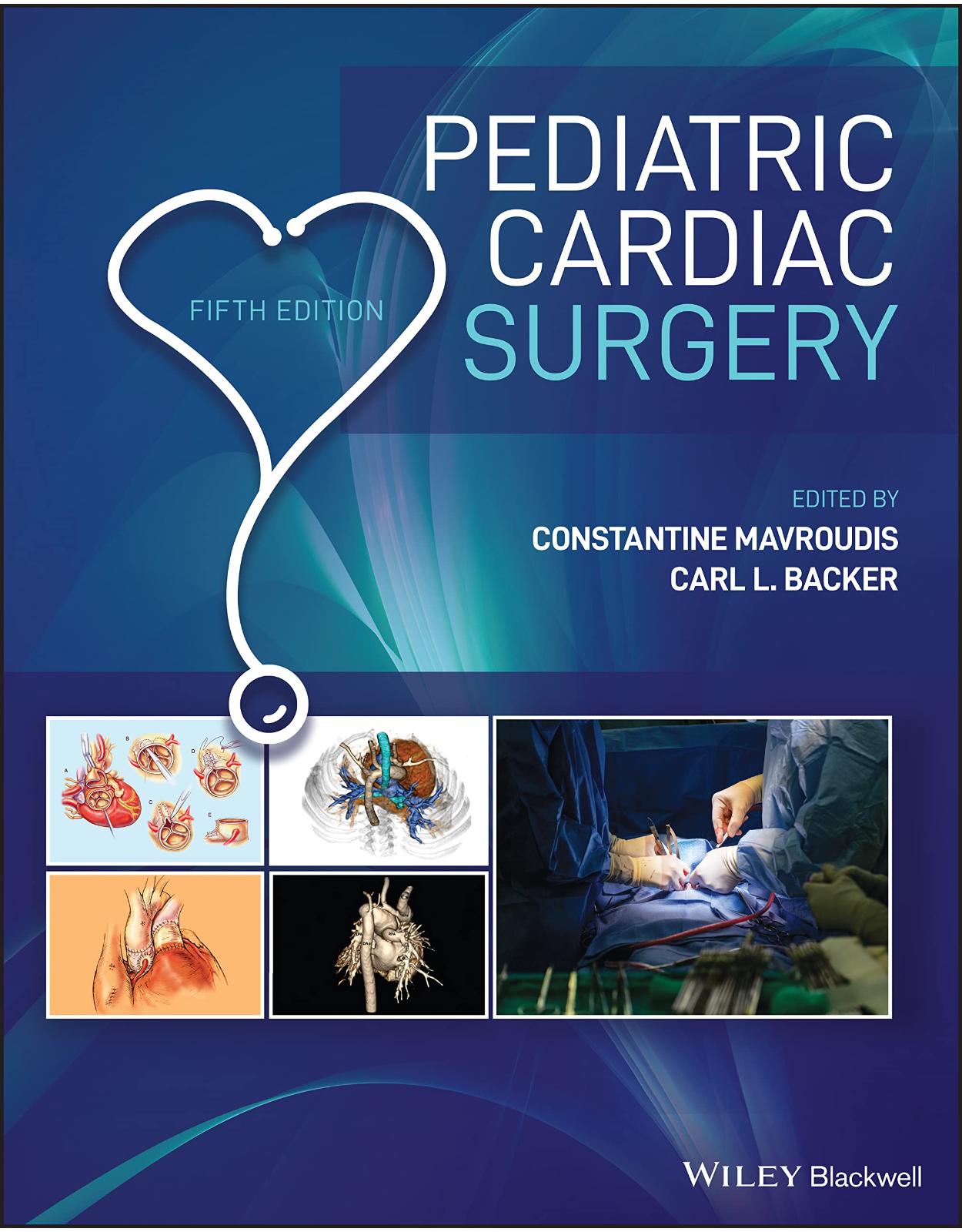
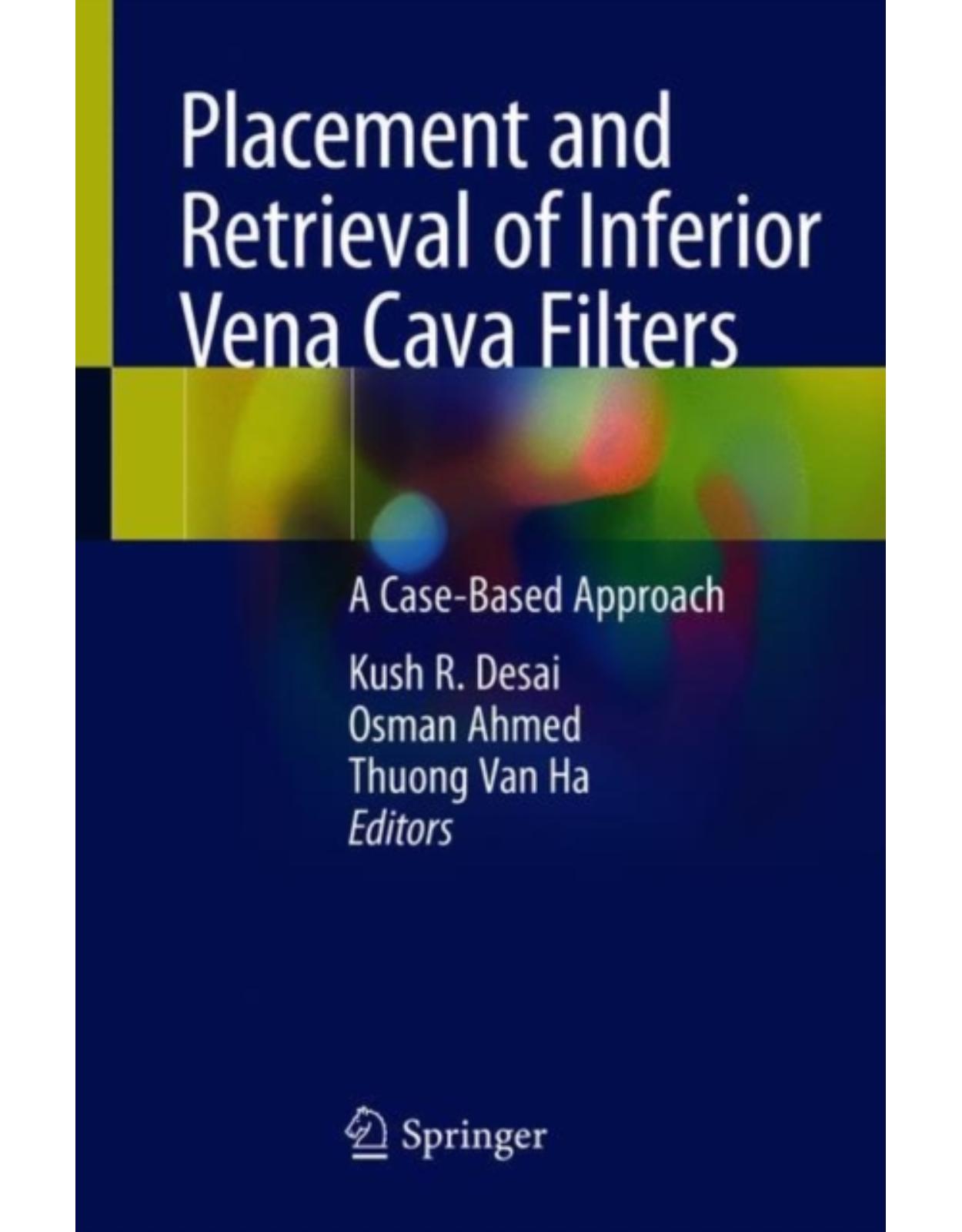
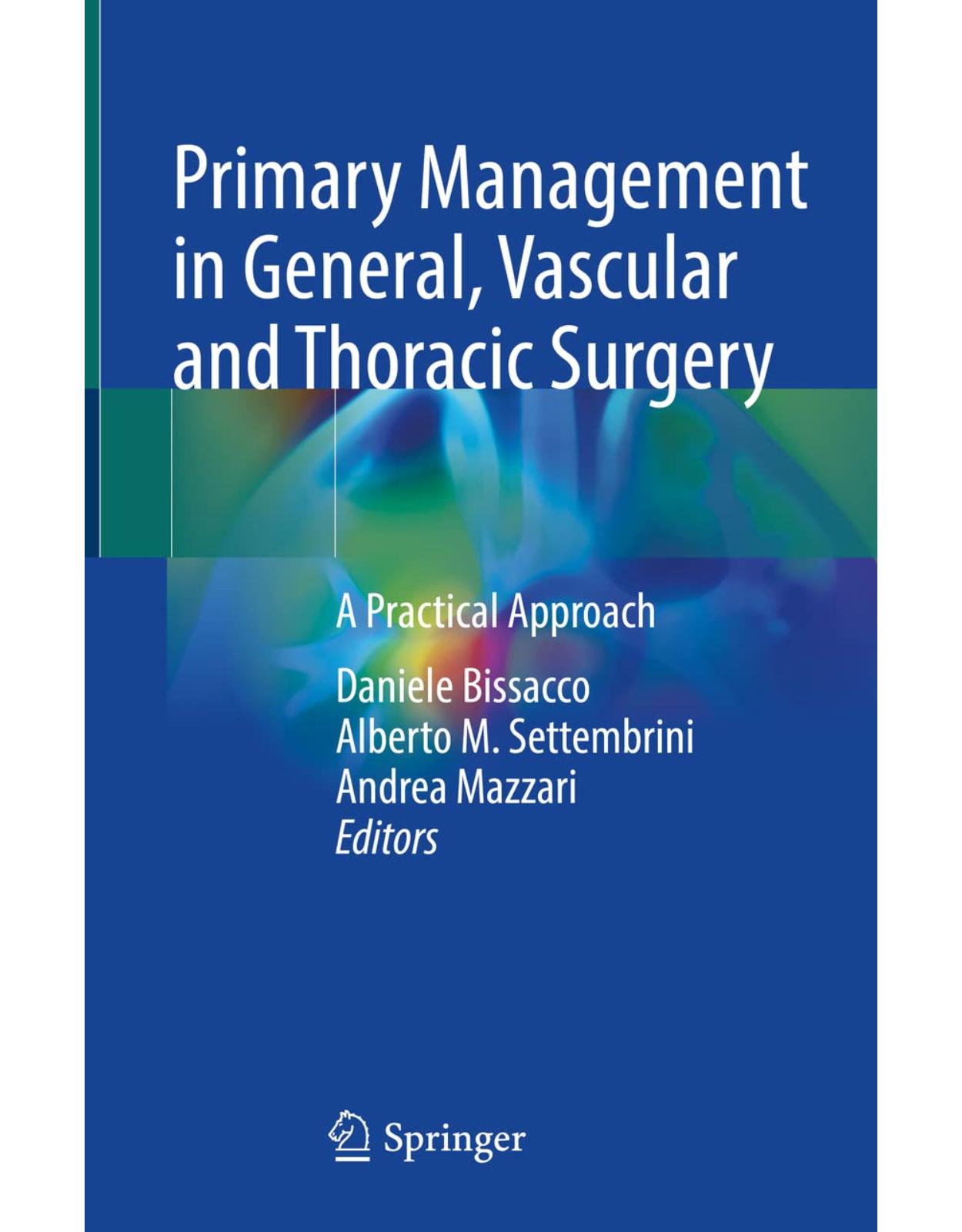
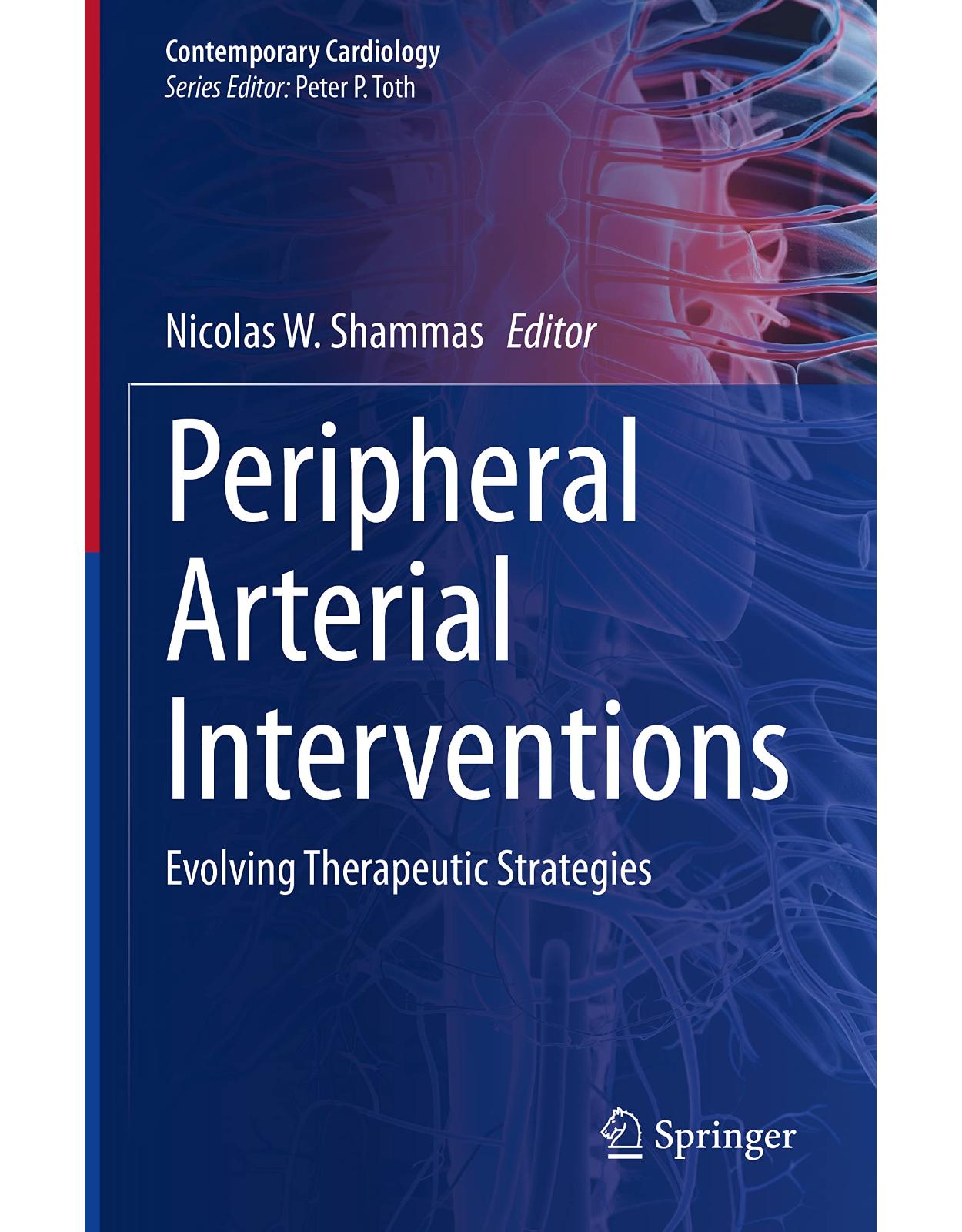
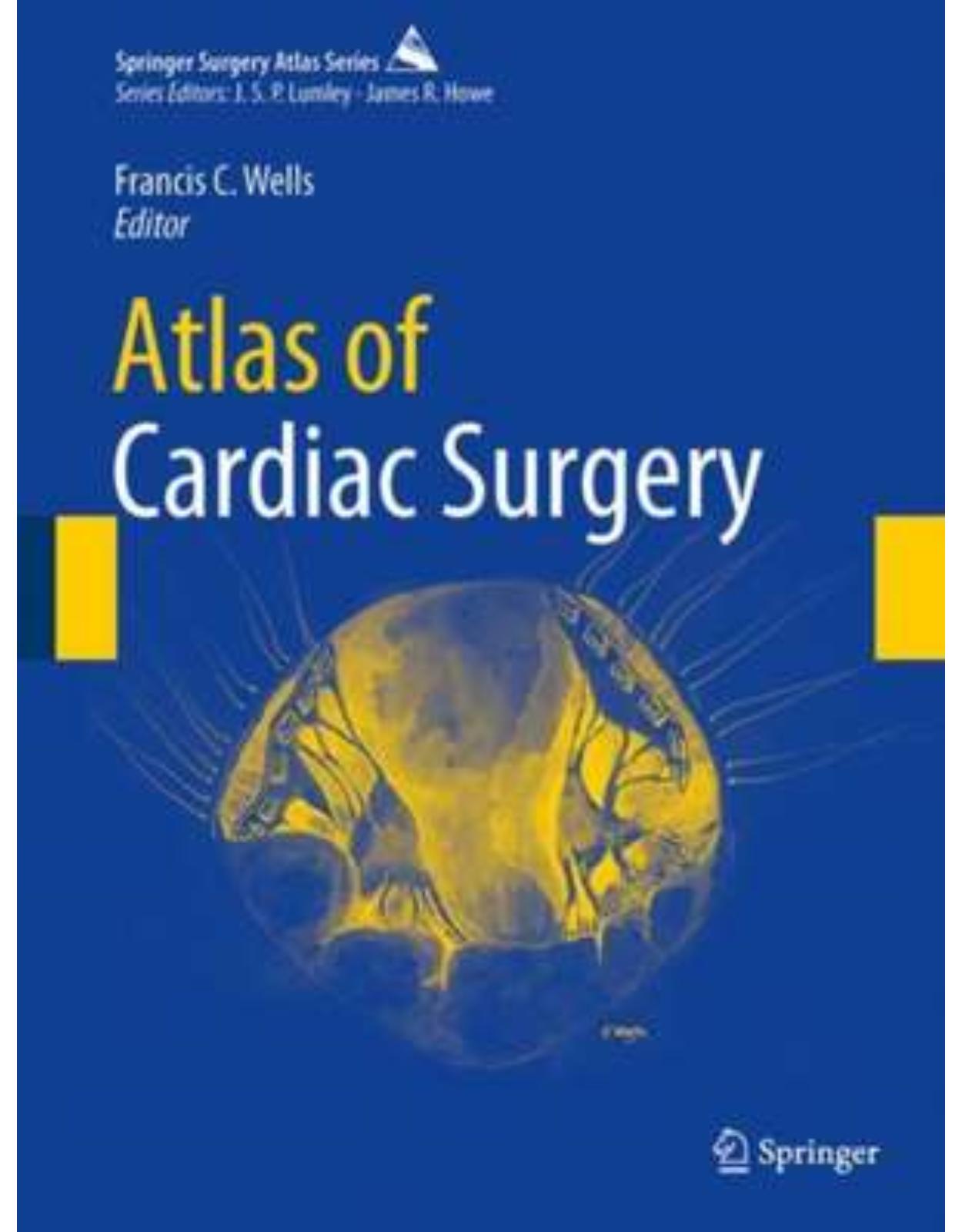
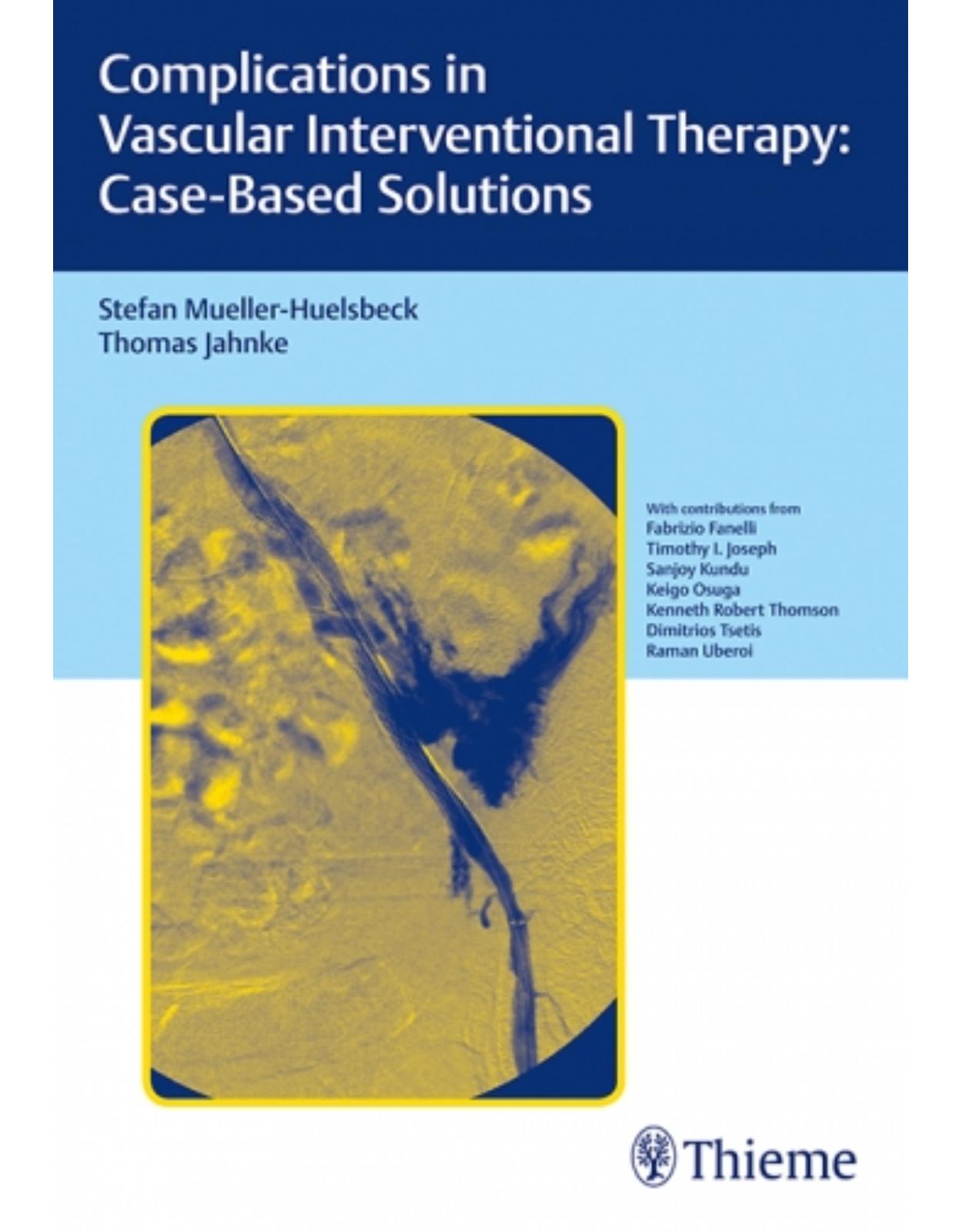
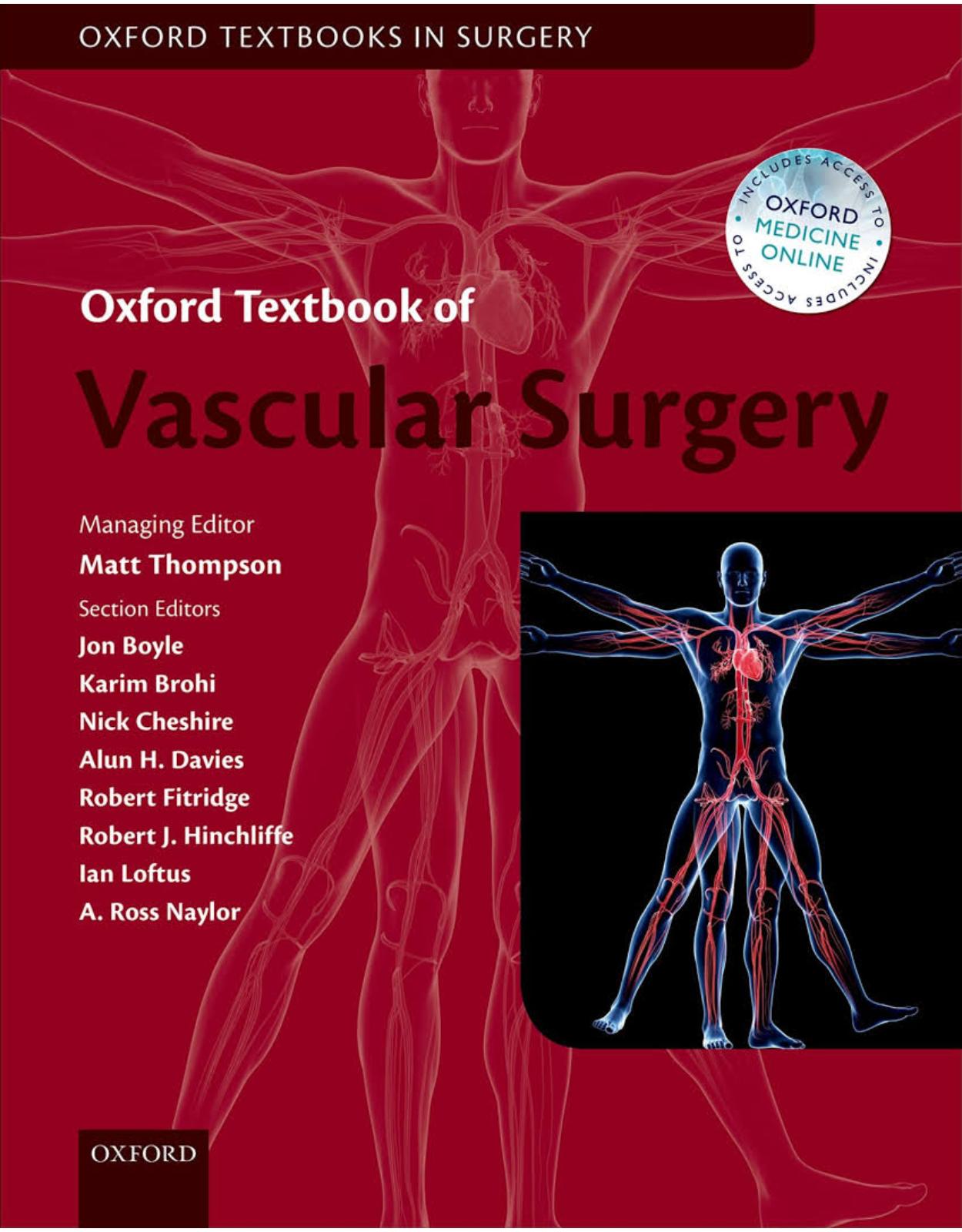
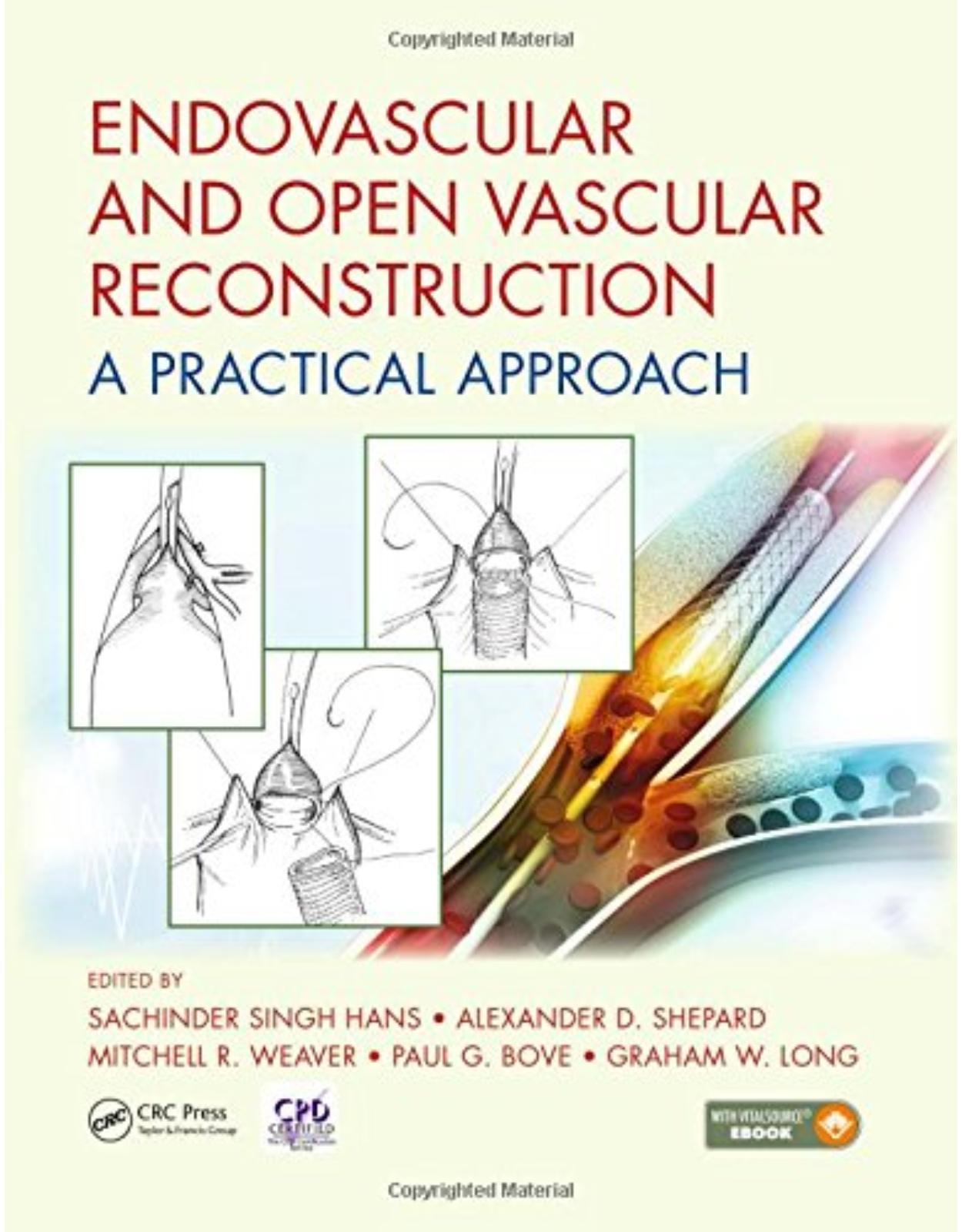
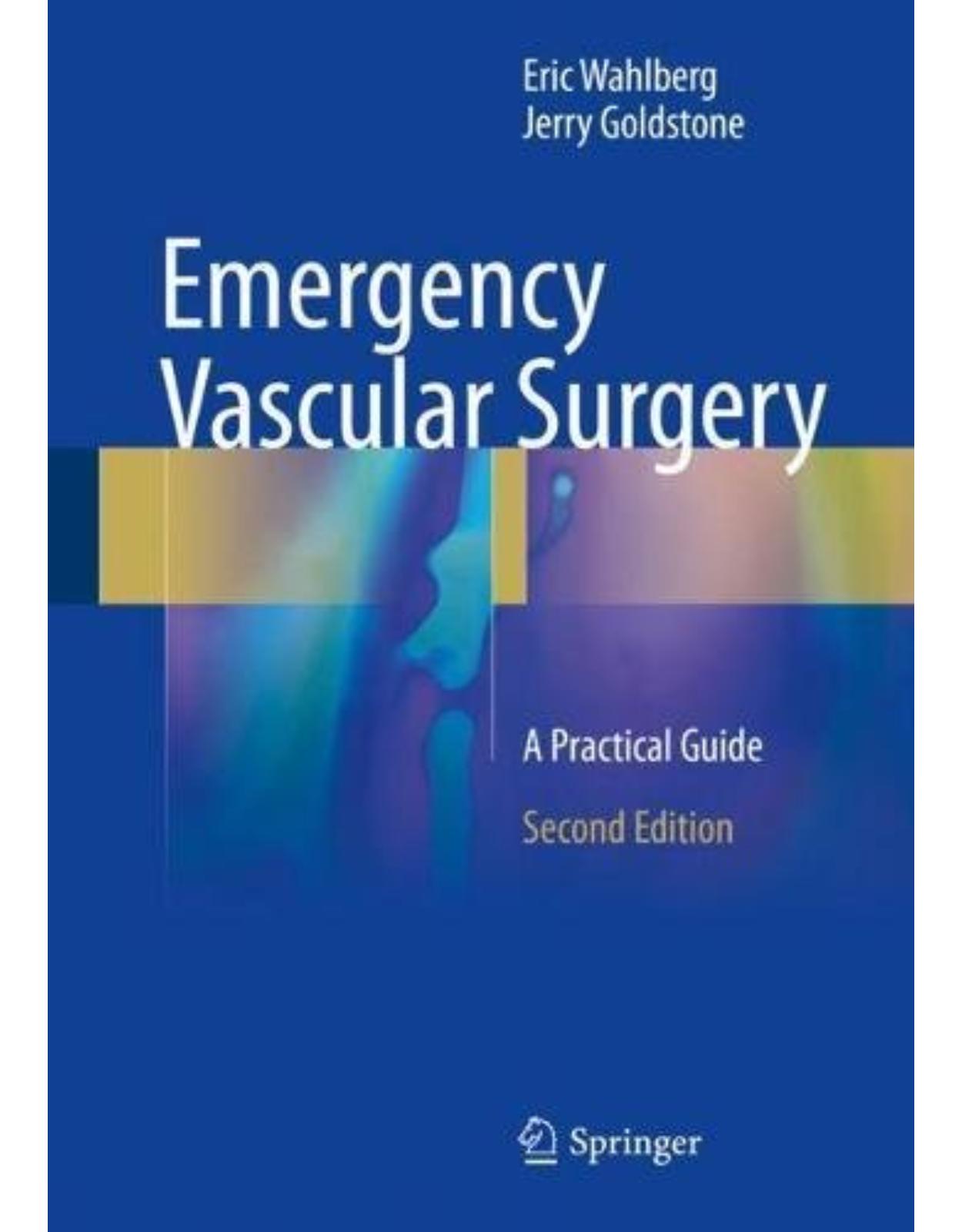
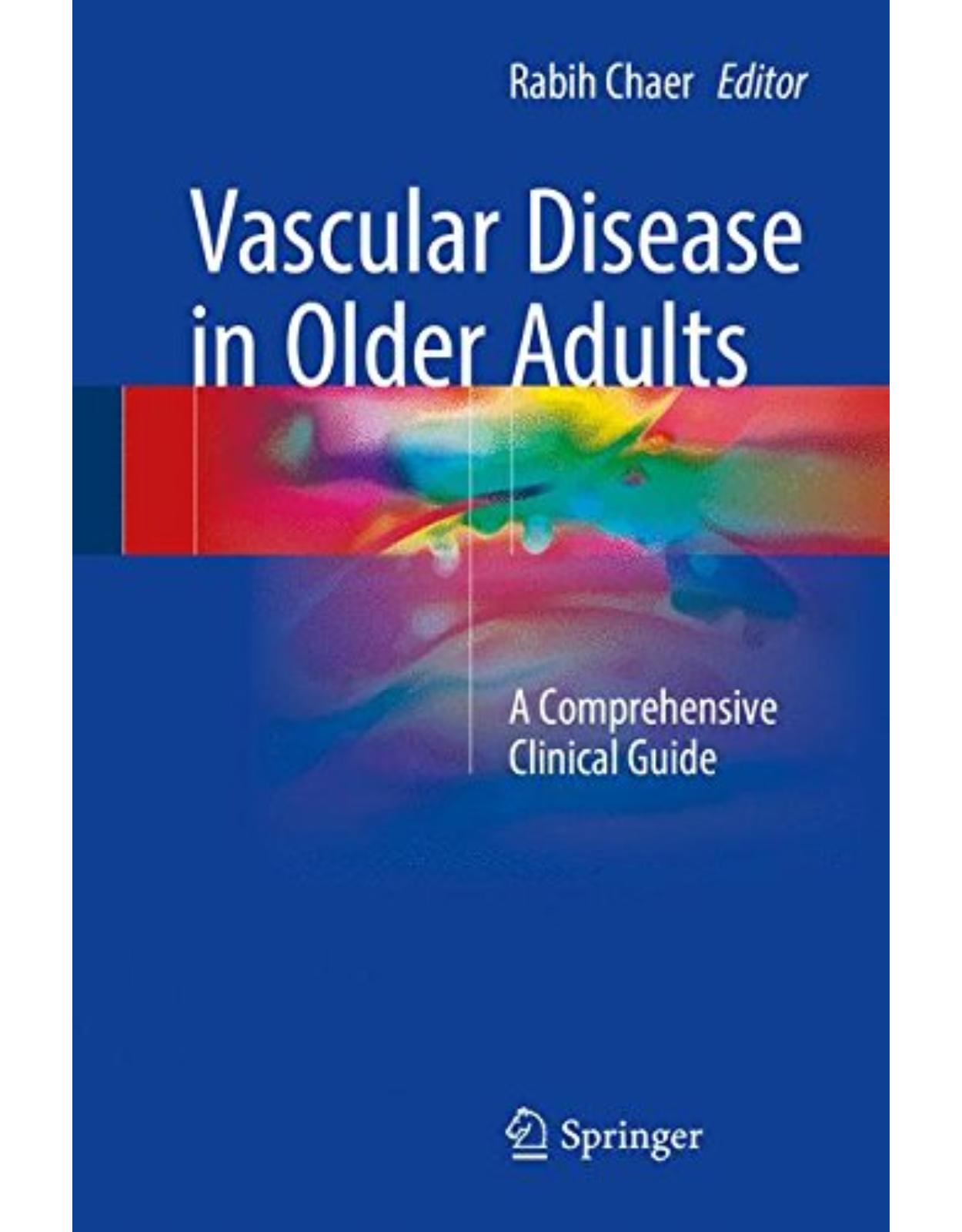
Clientii ebookshop.ro nu au adaugat inca opinii pentru acest produs. Fii primul care adauga o parere, folosind formularul de mai jos.